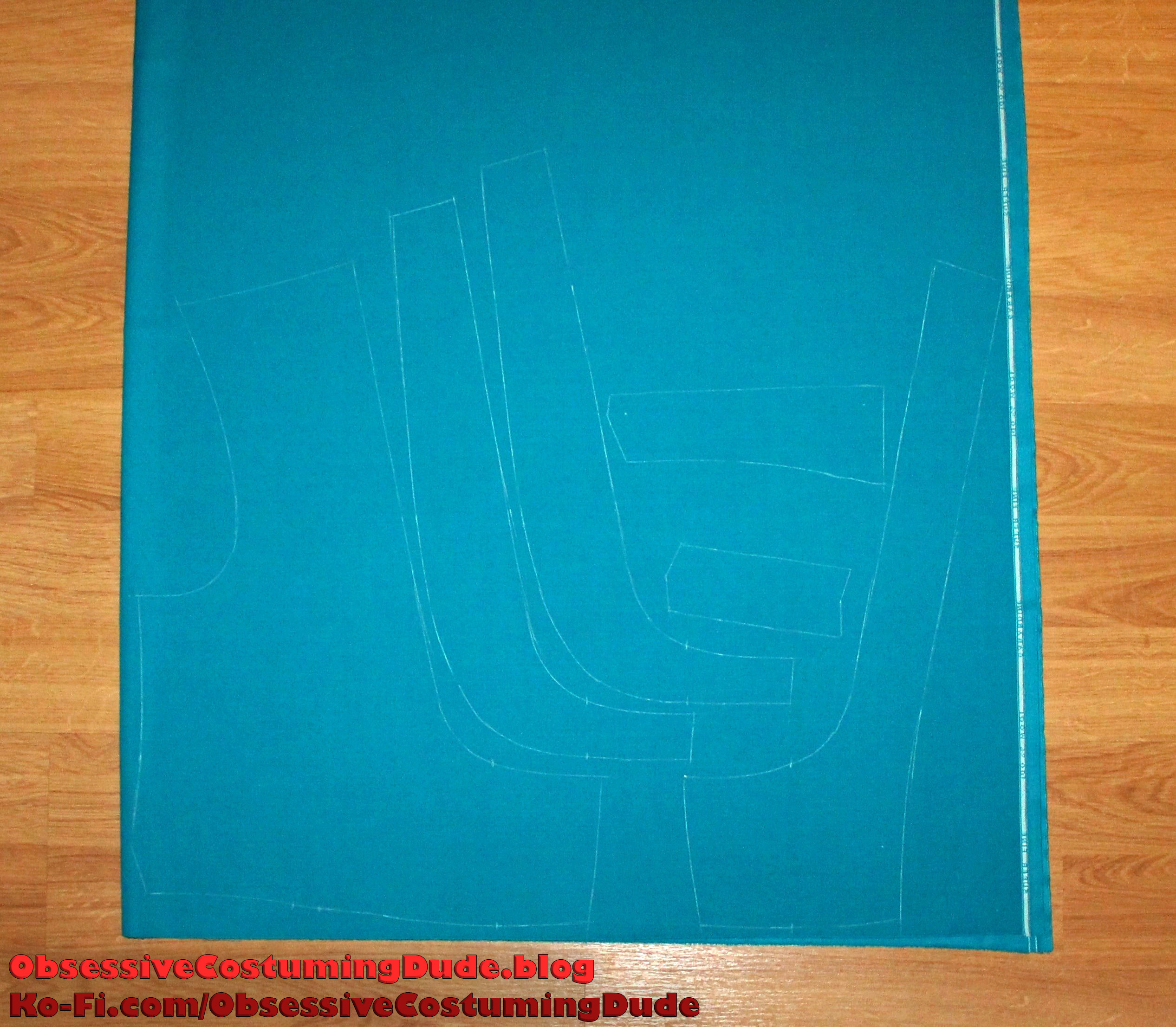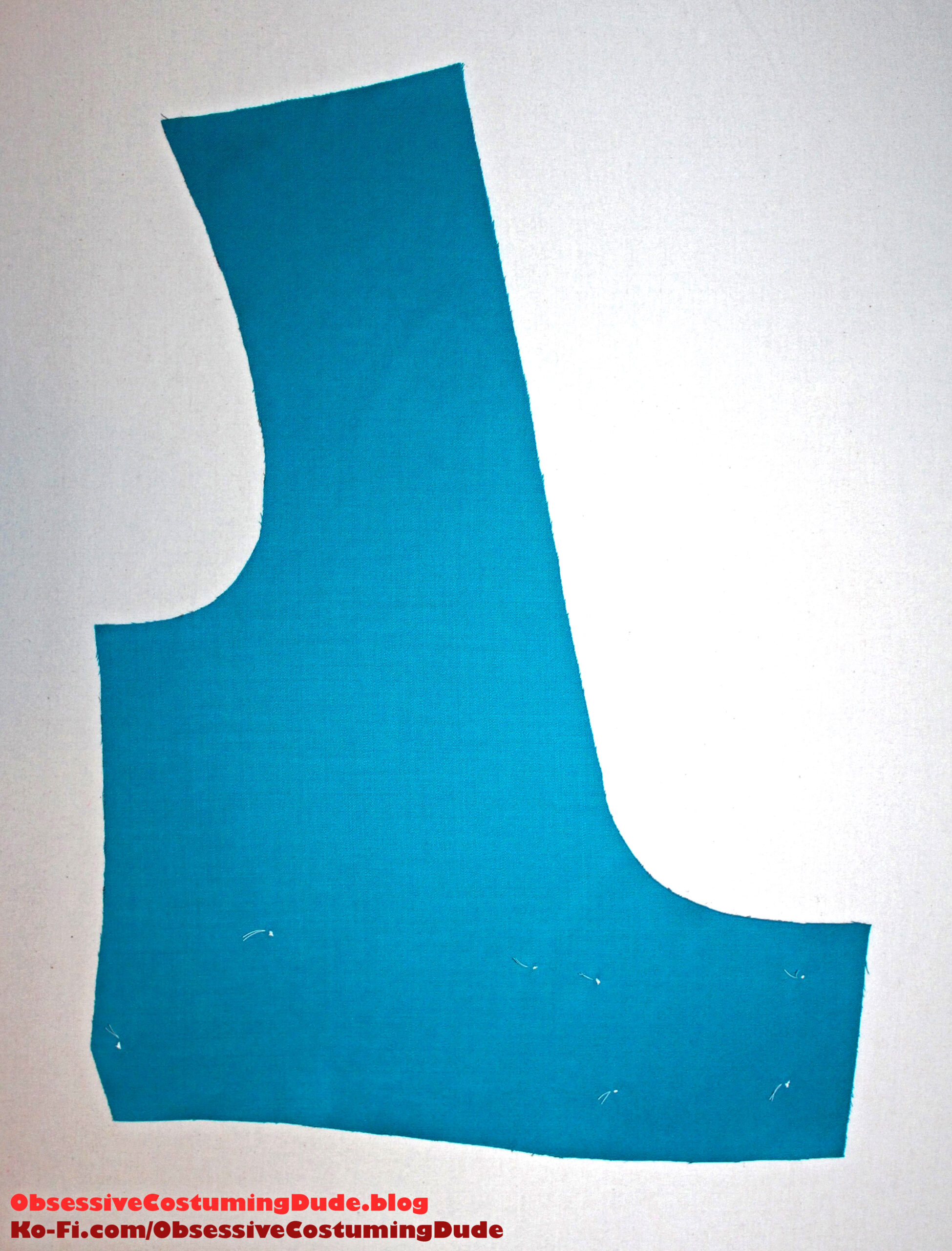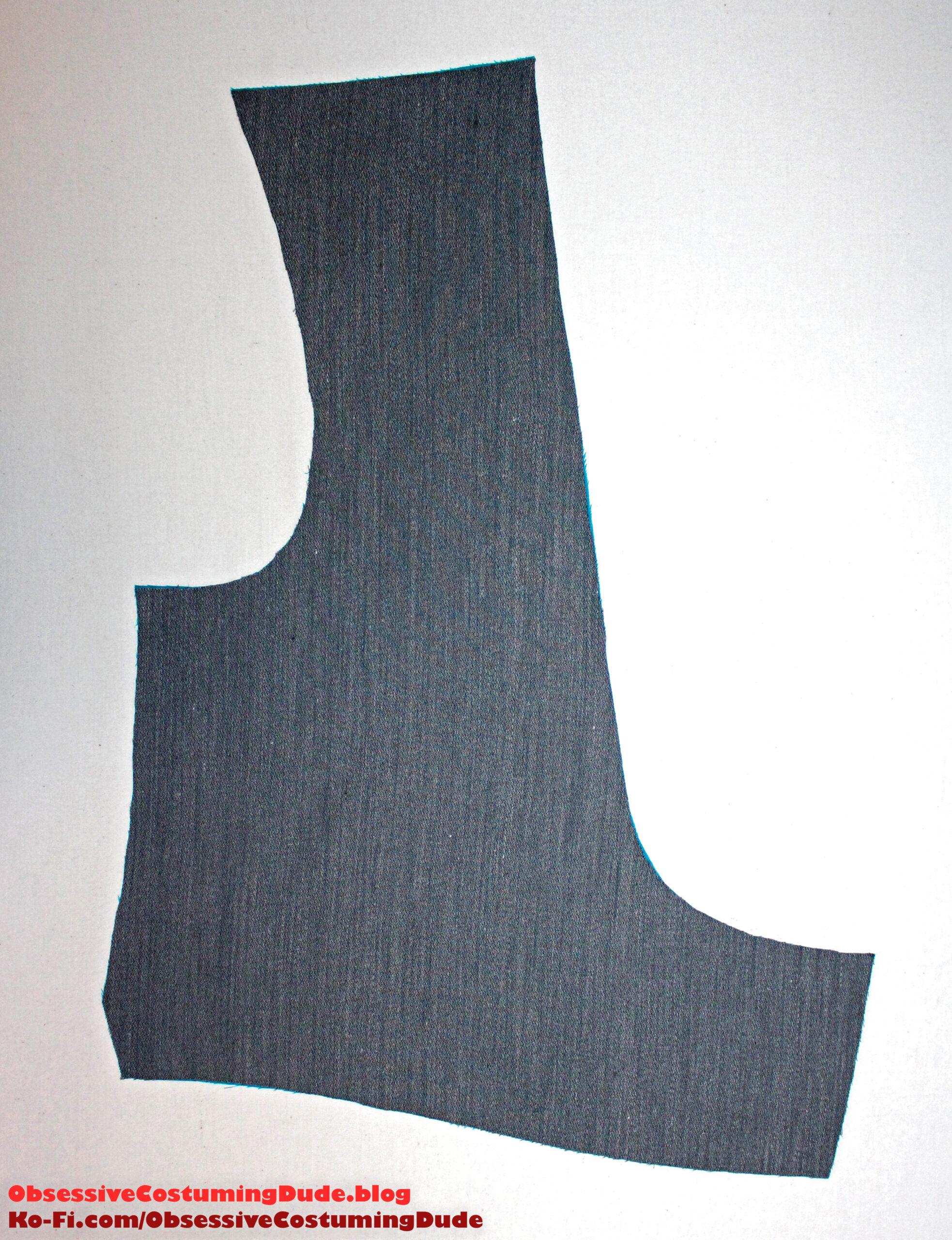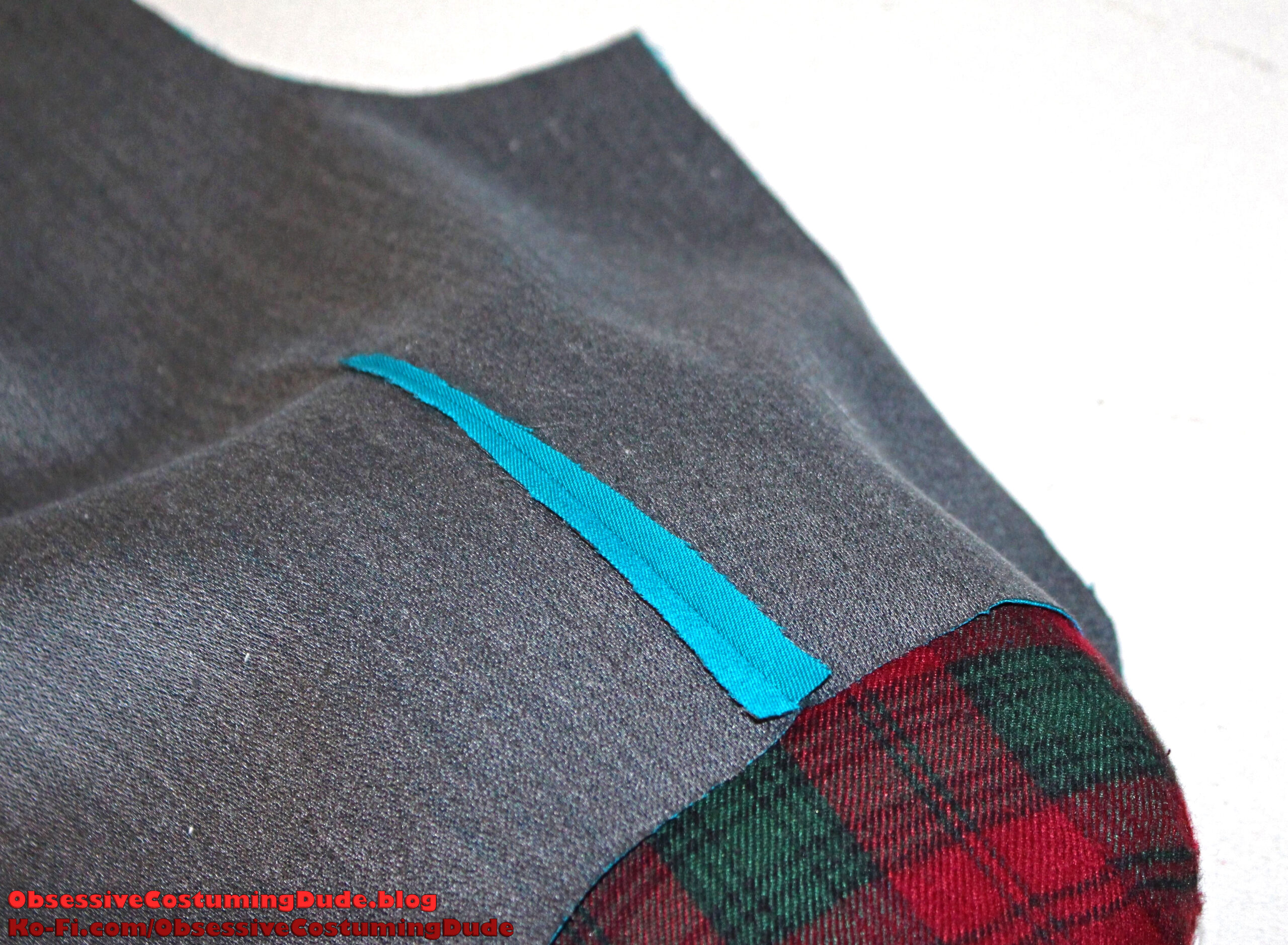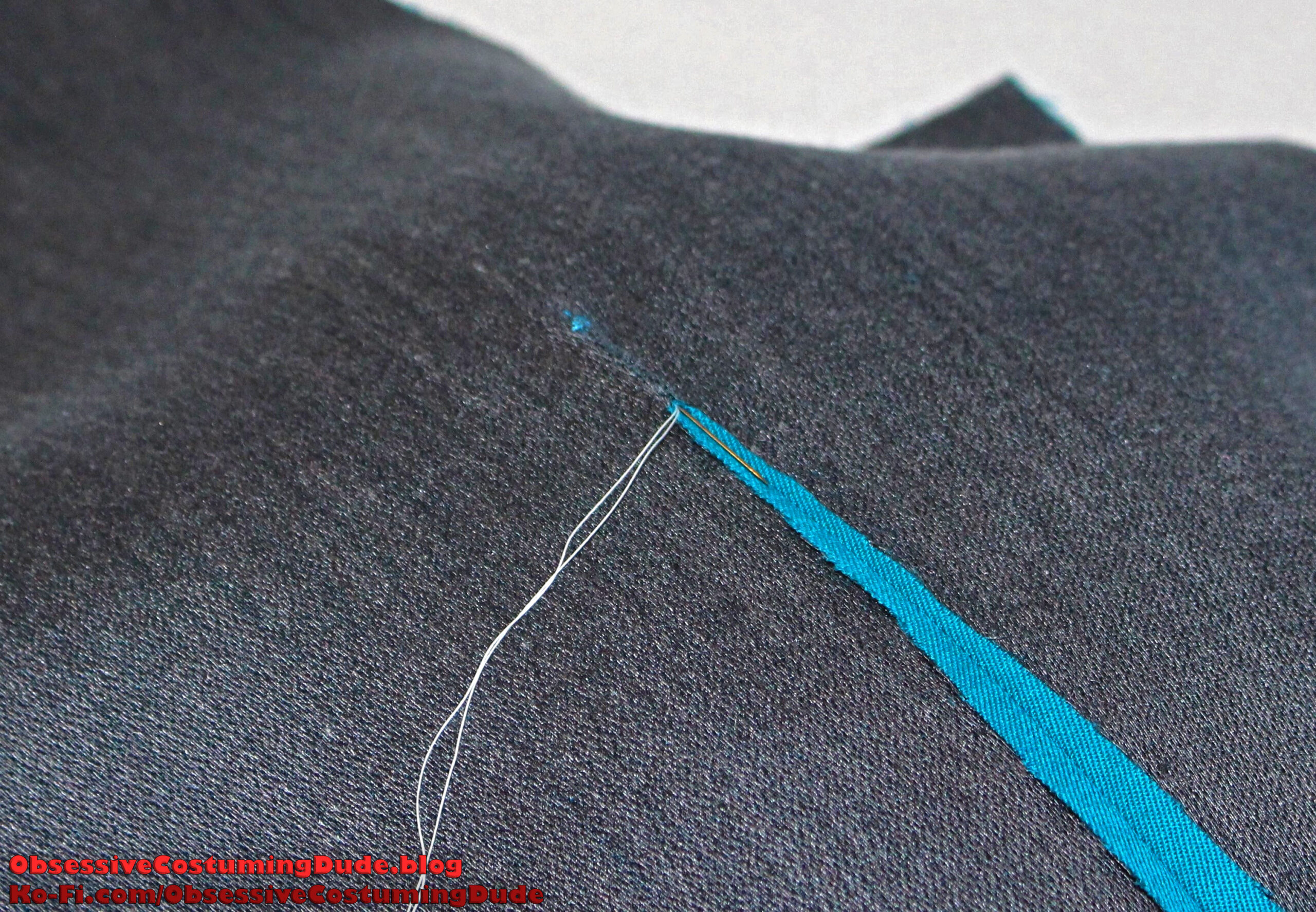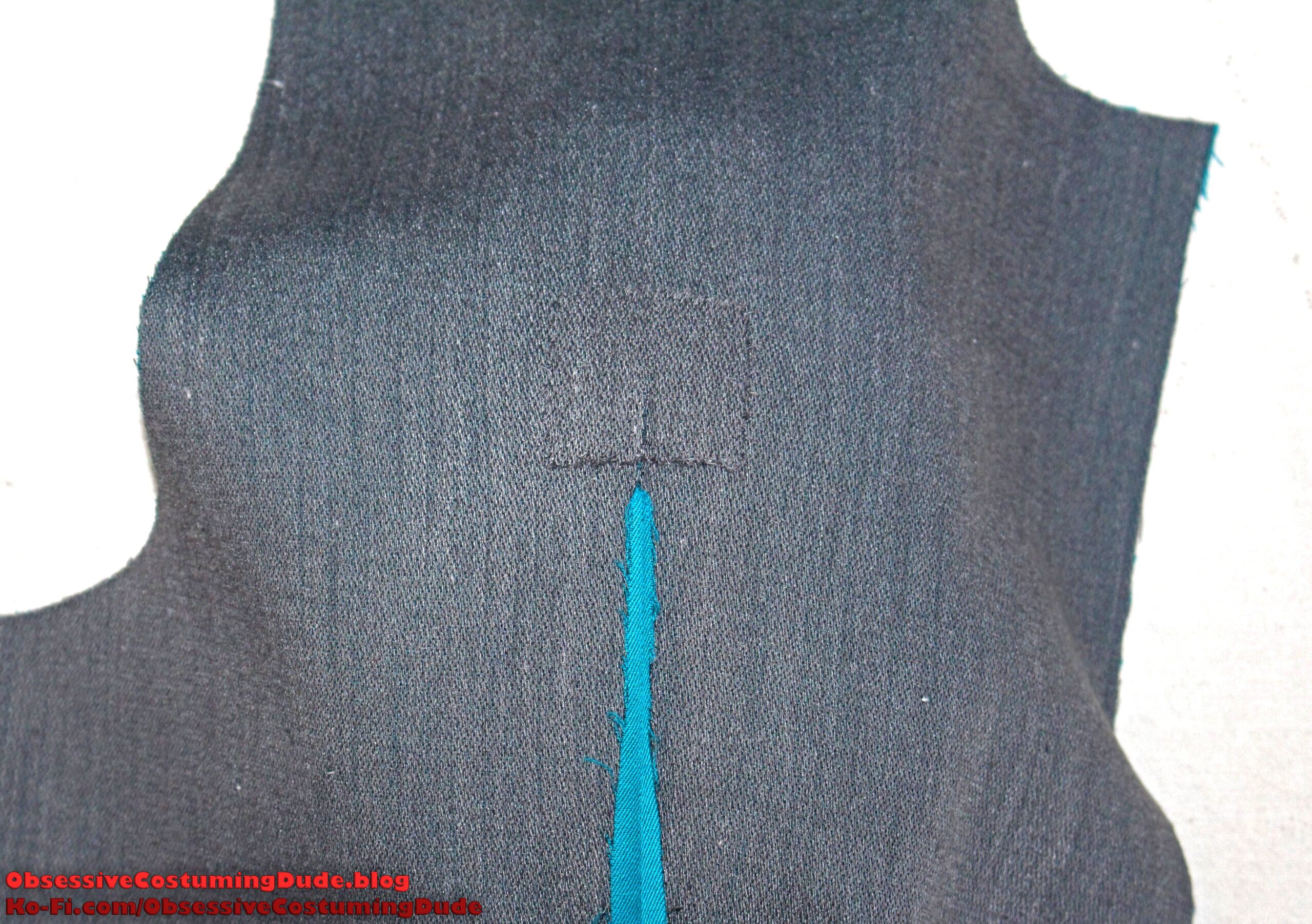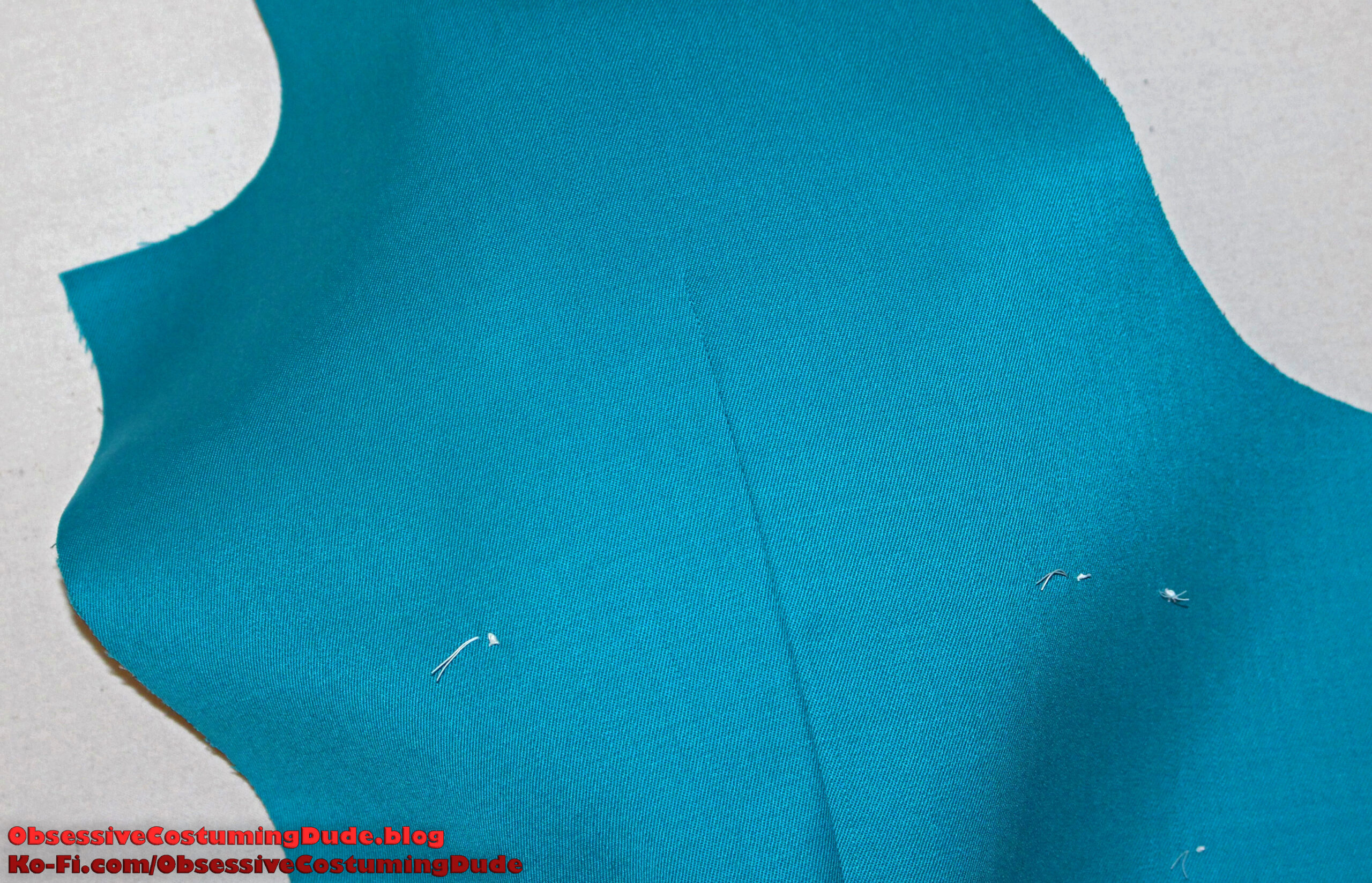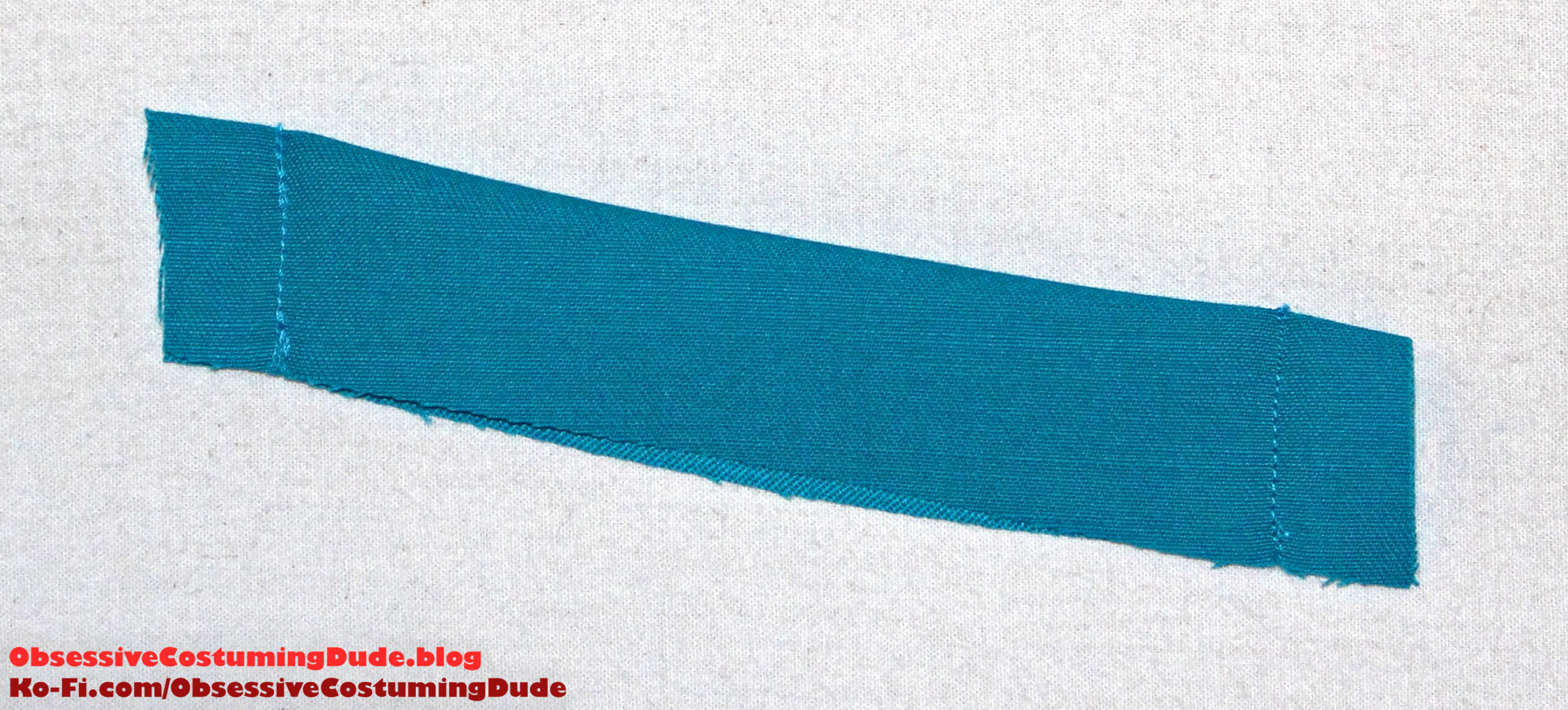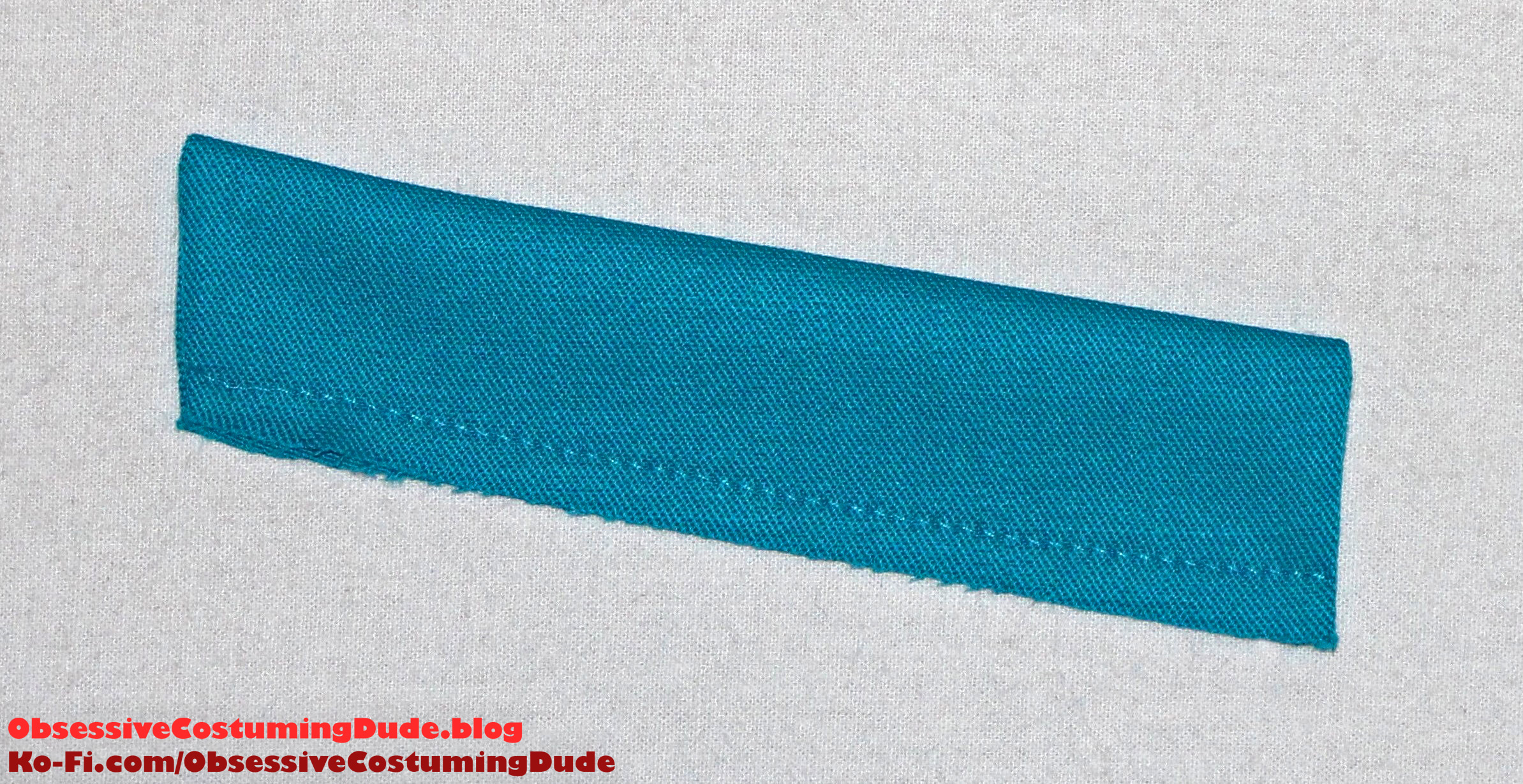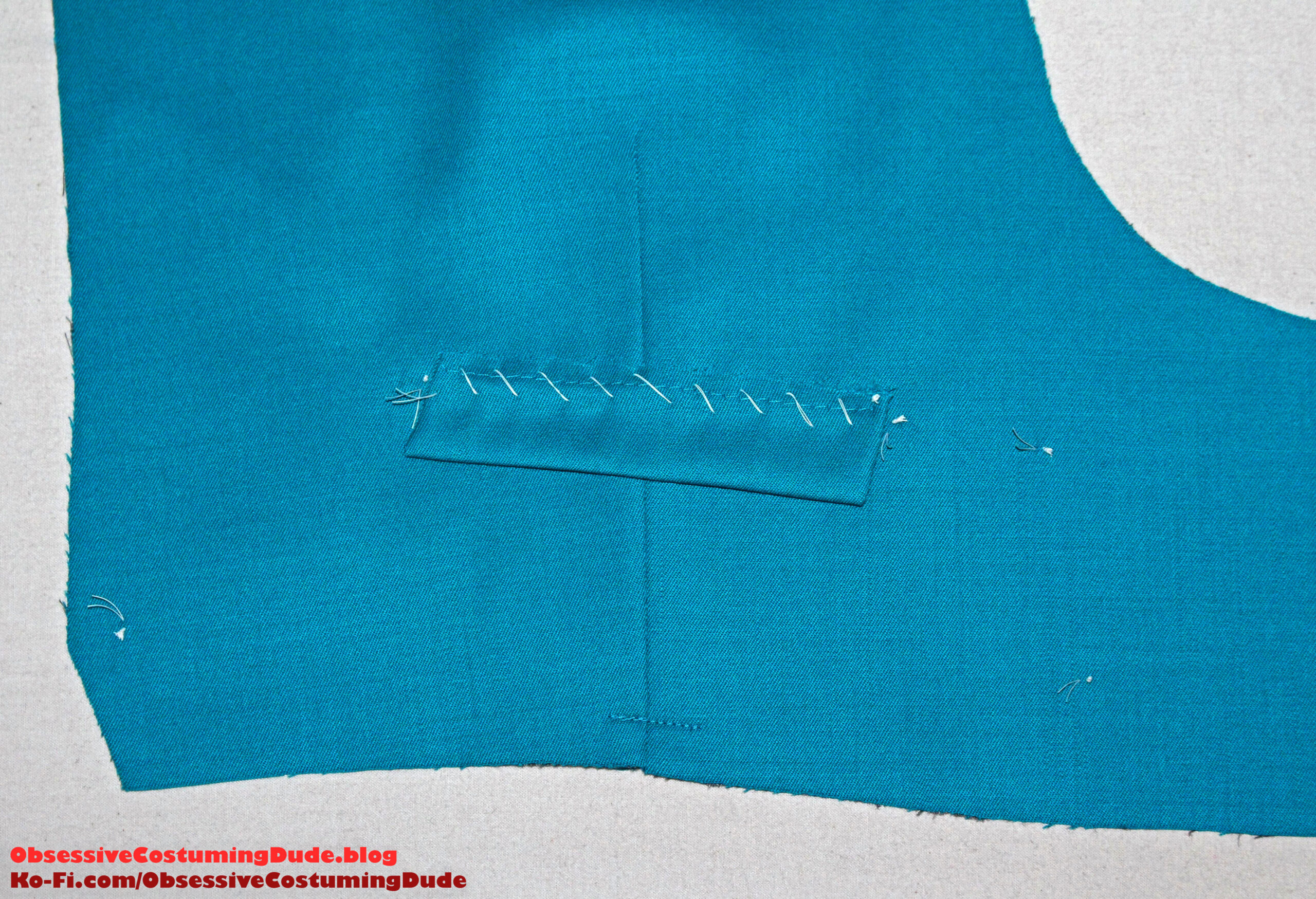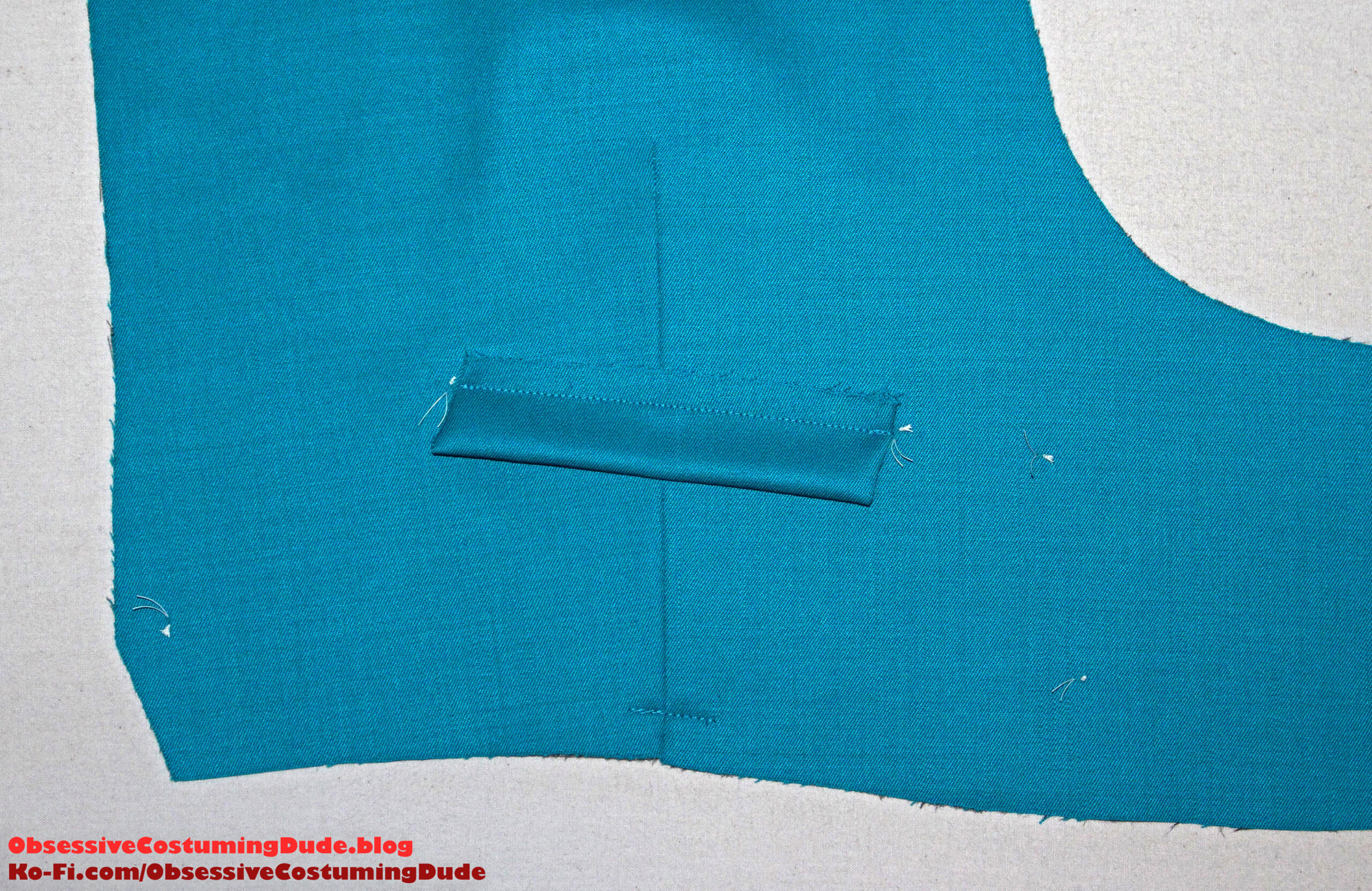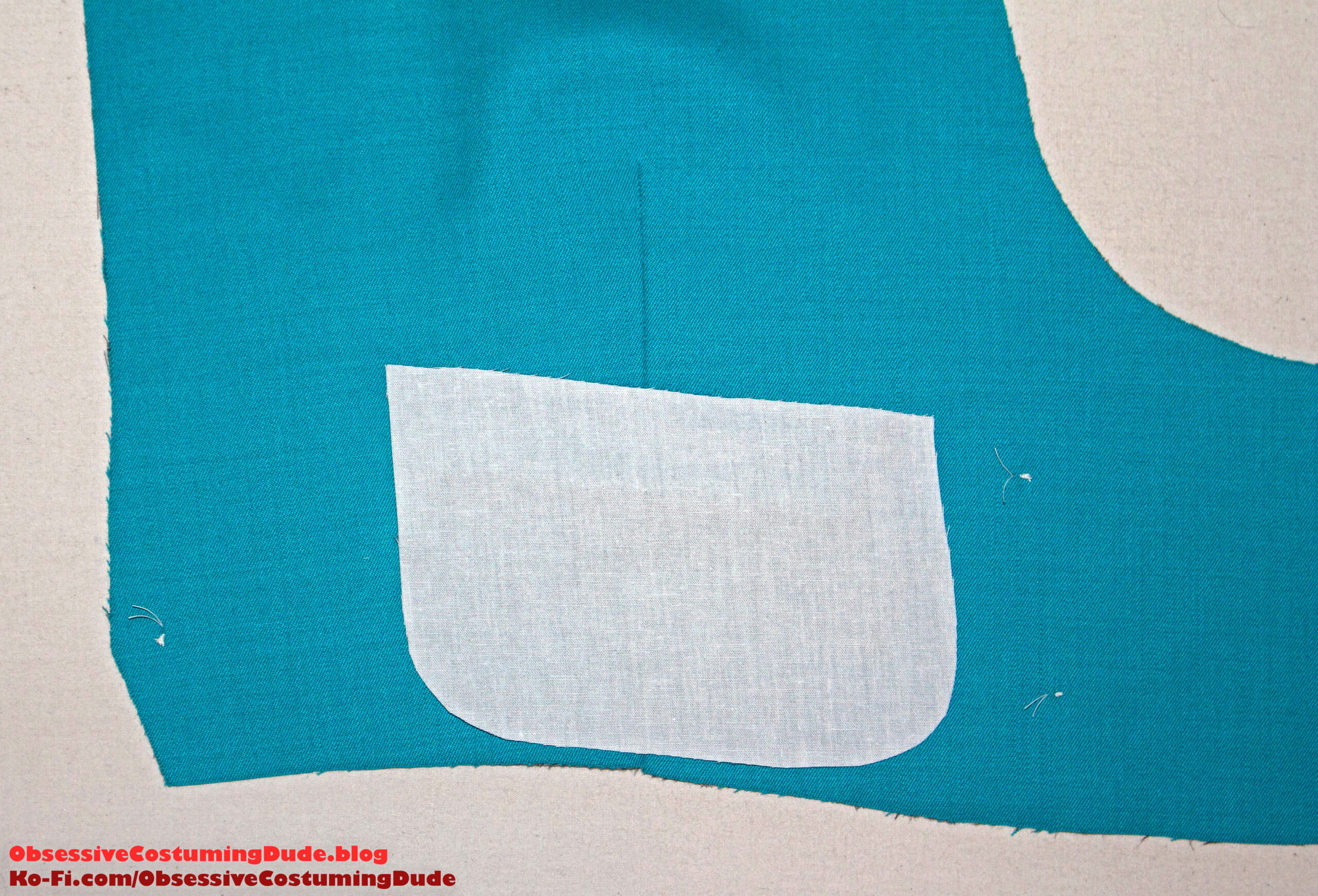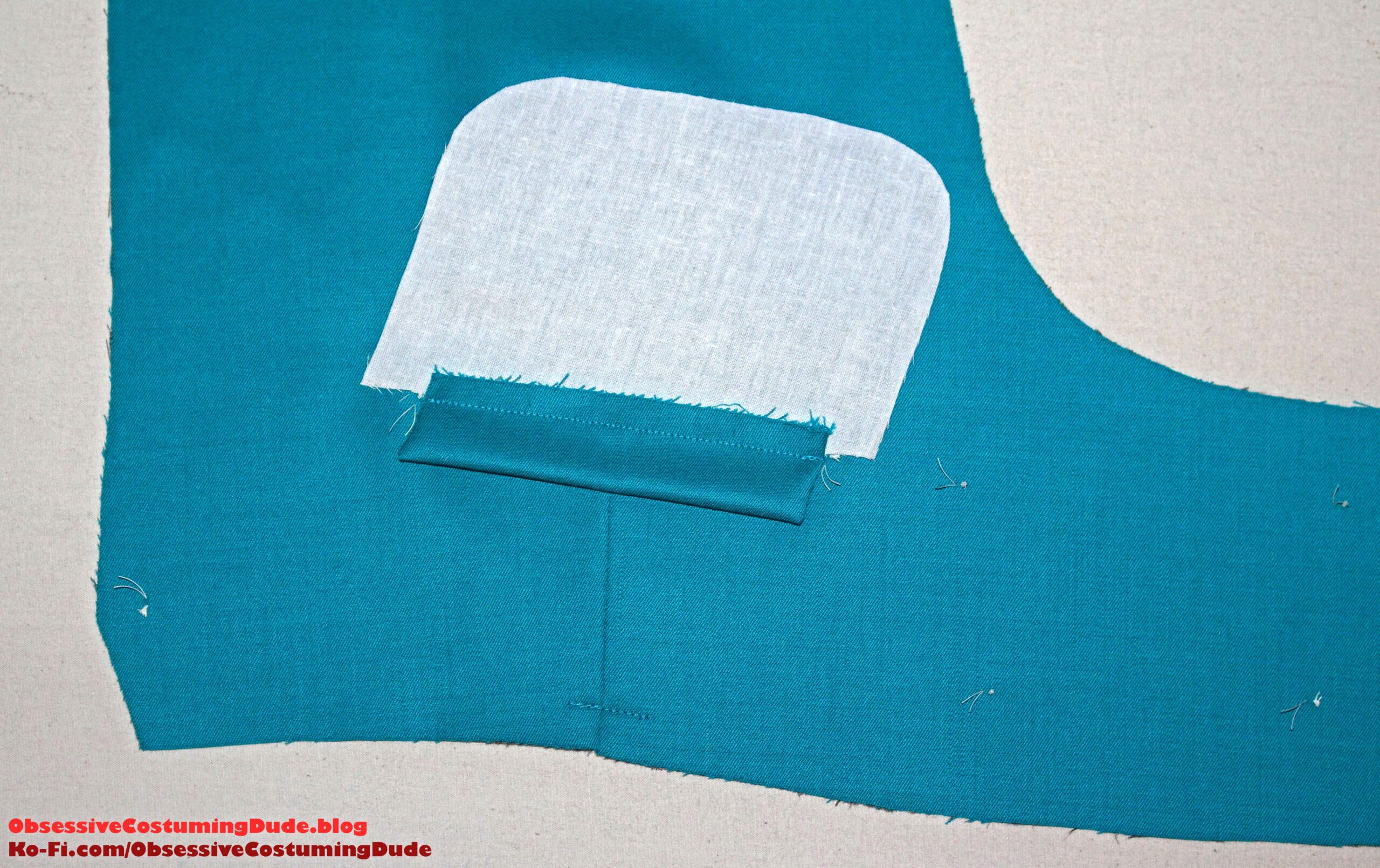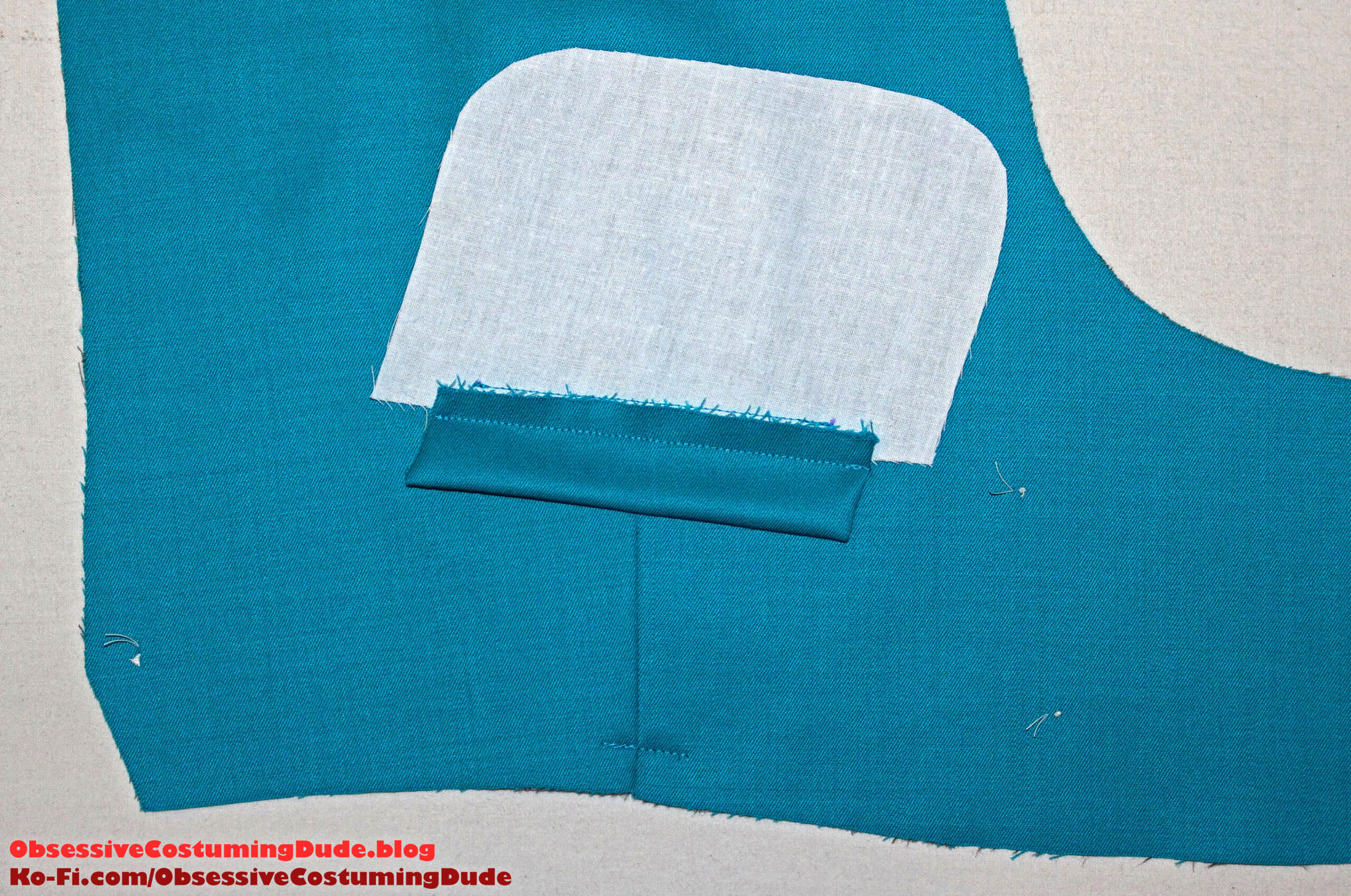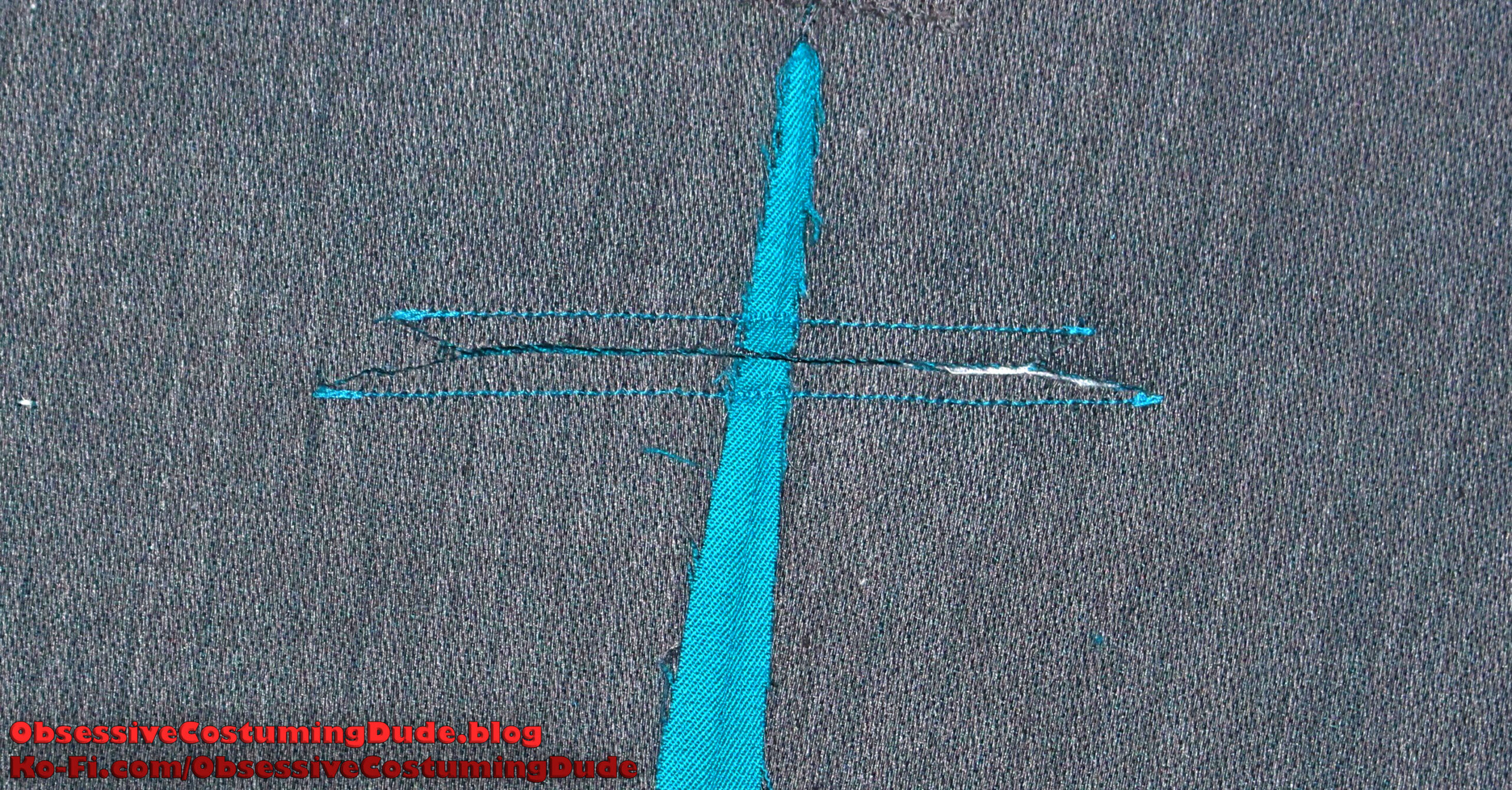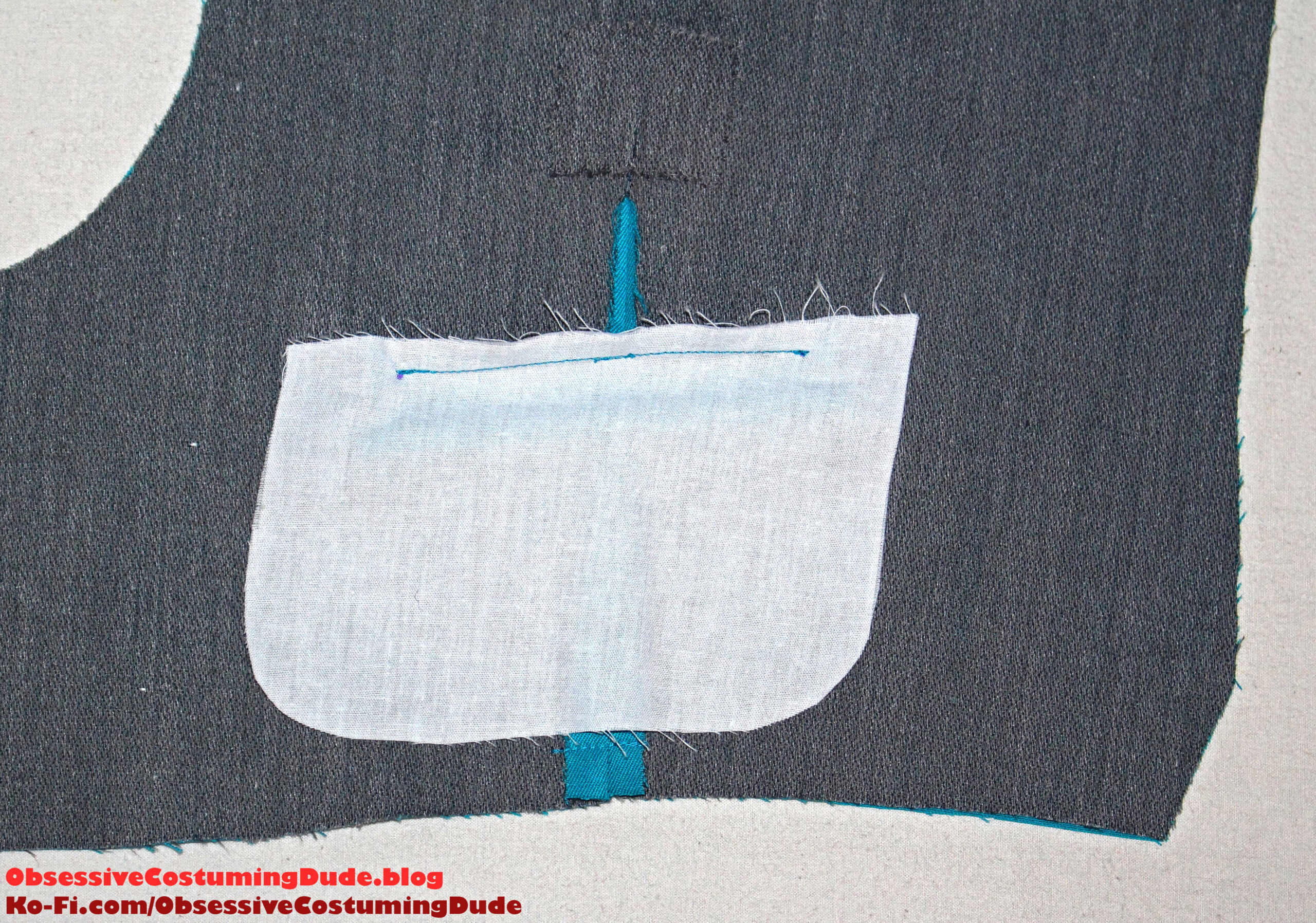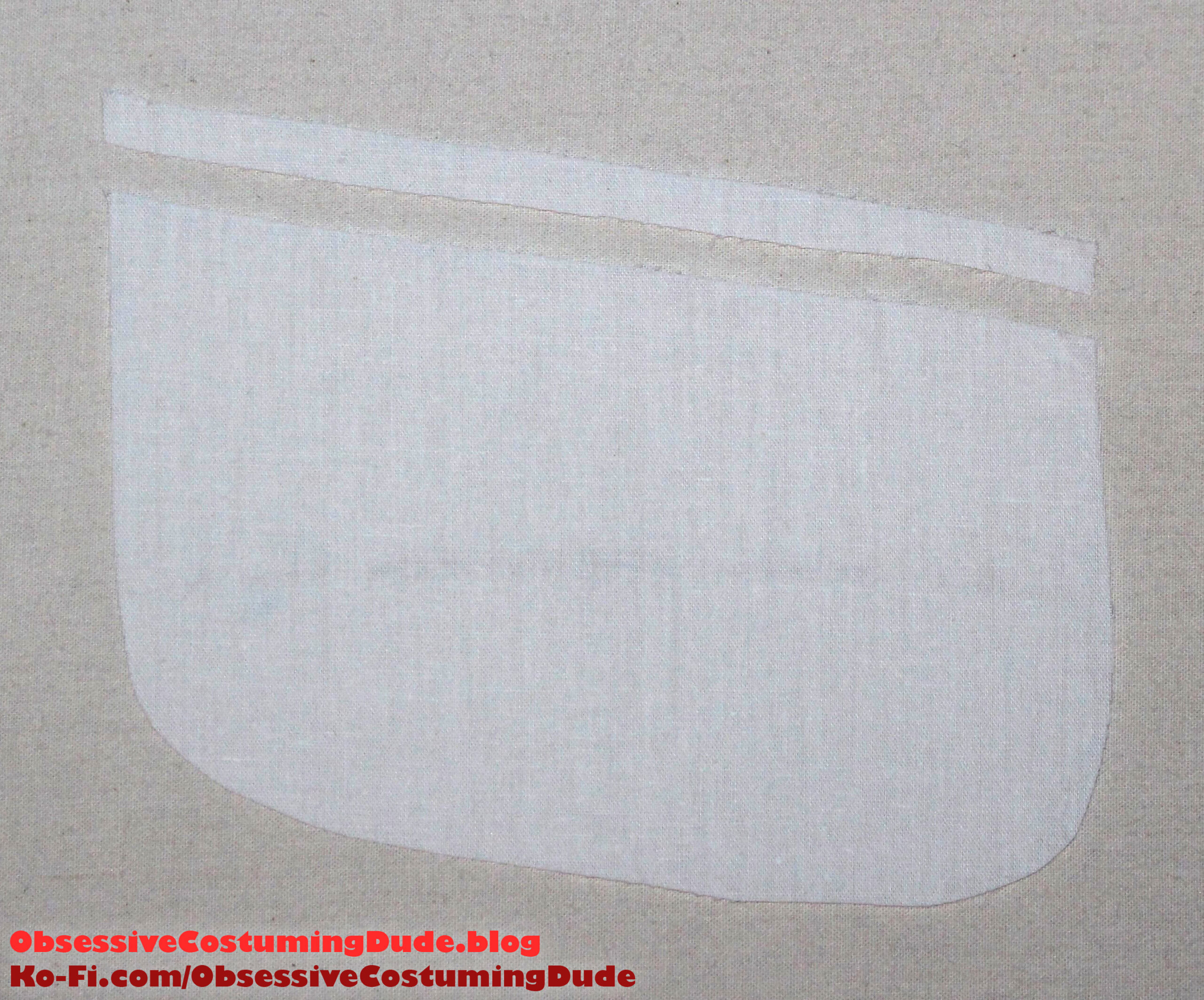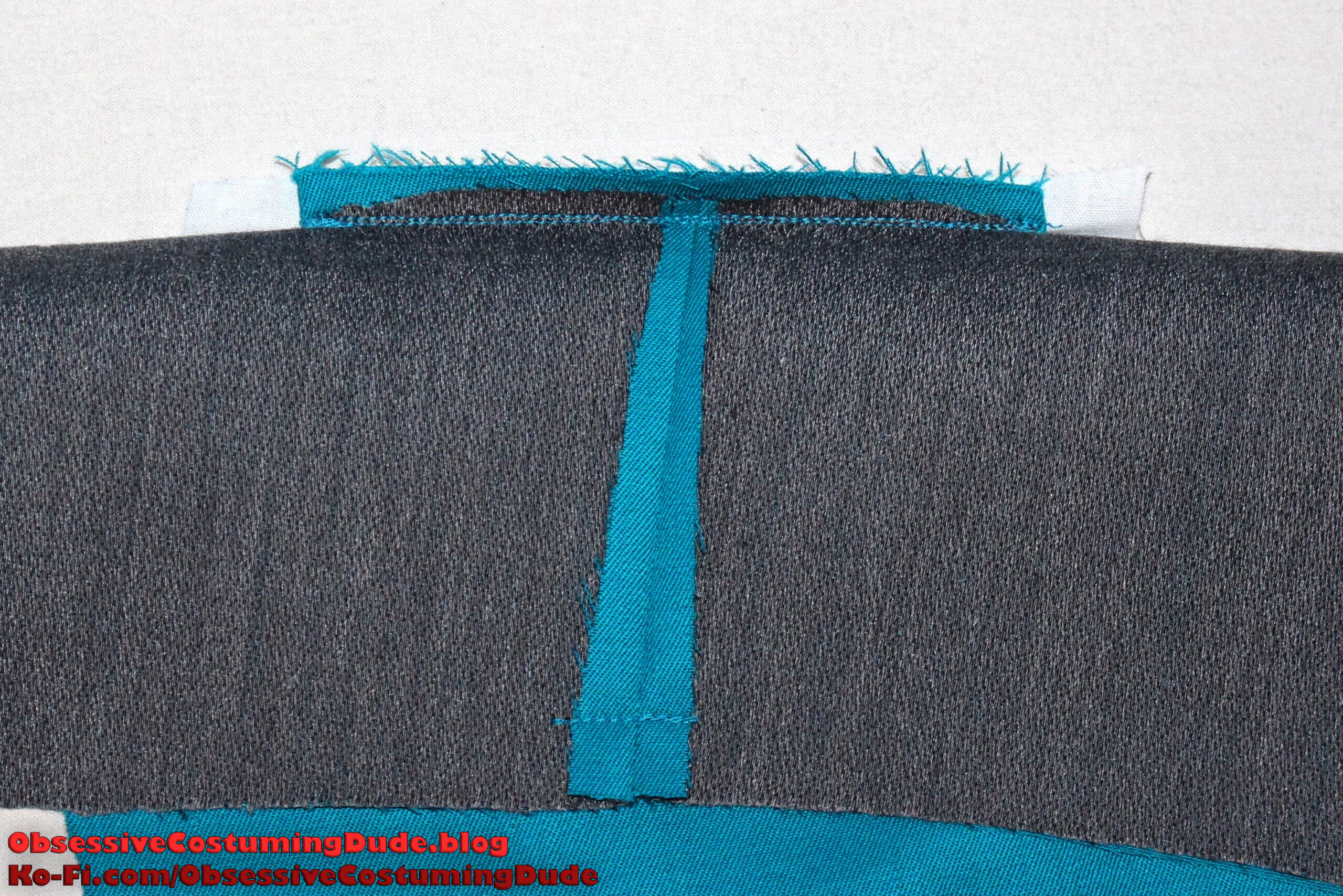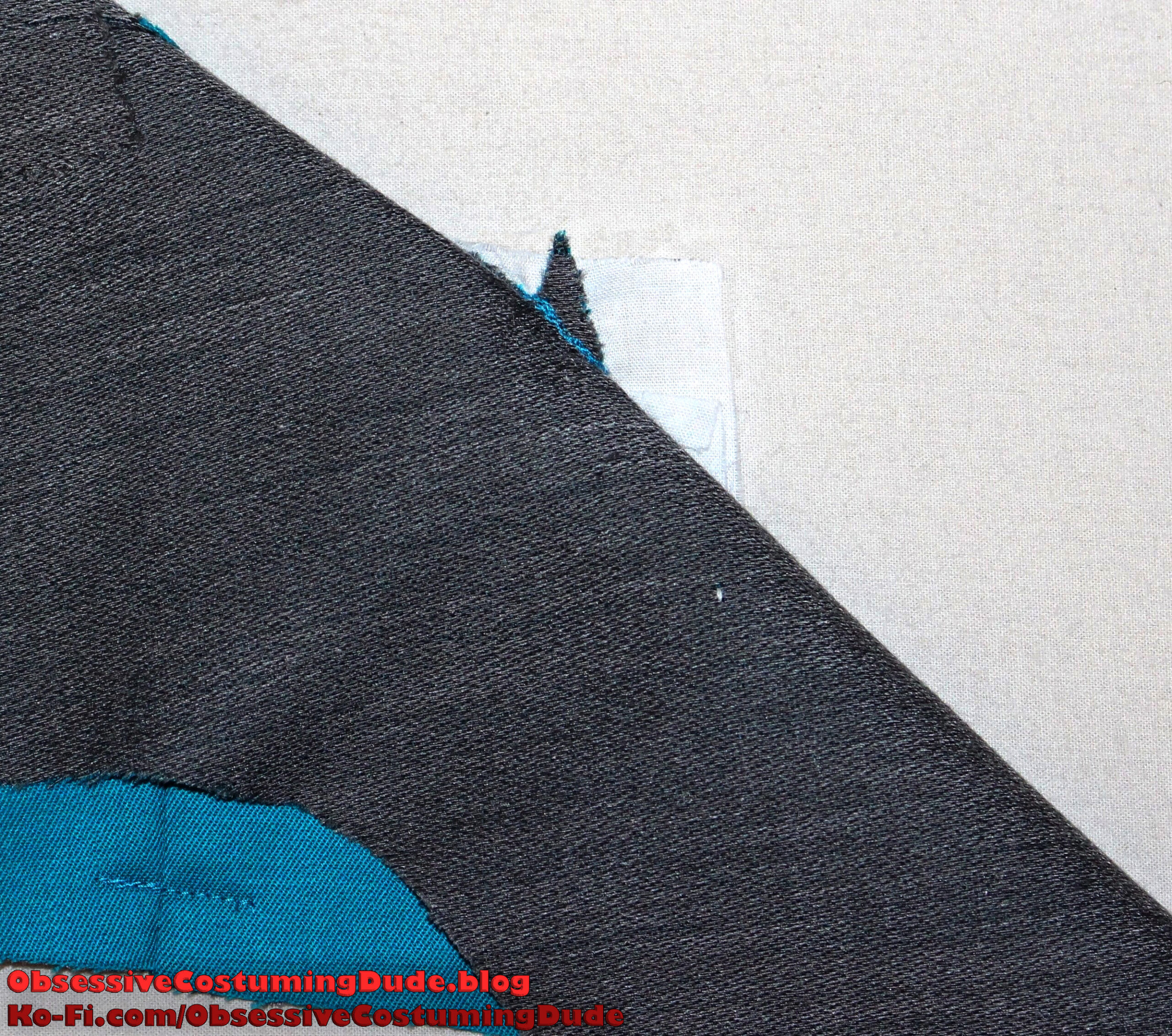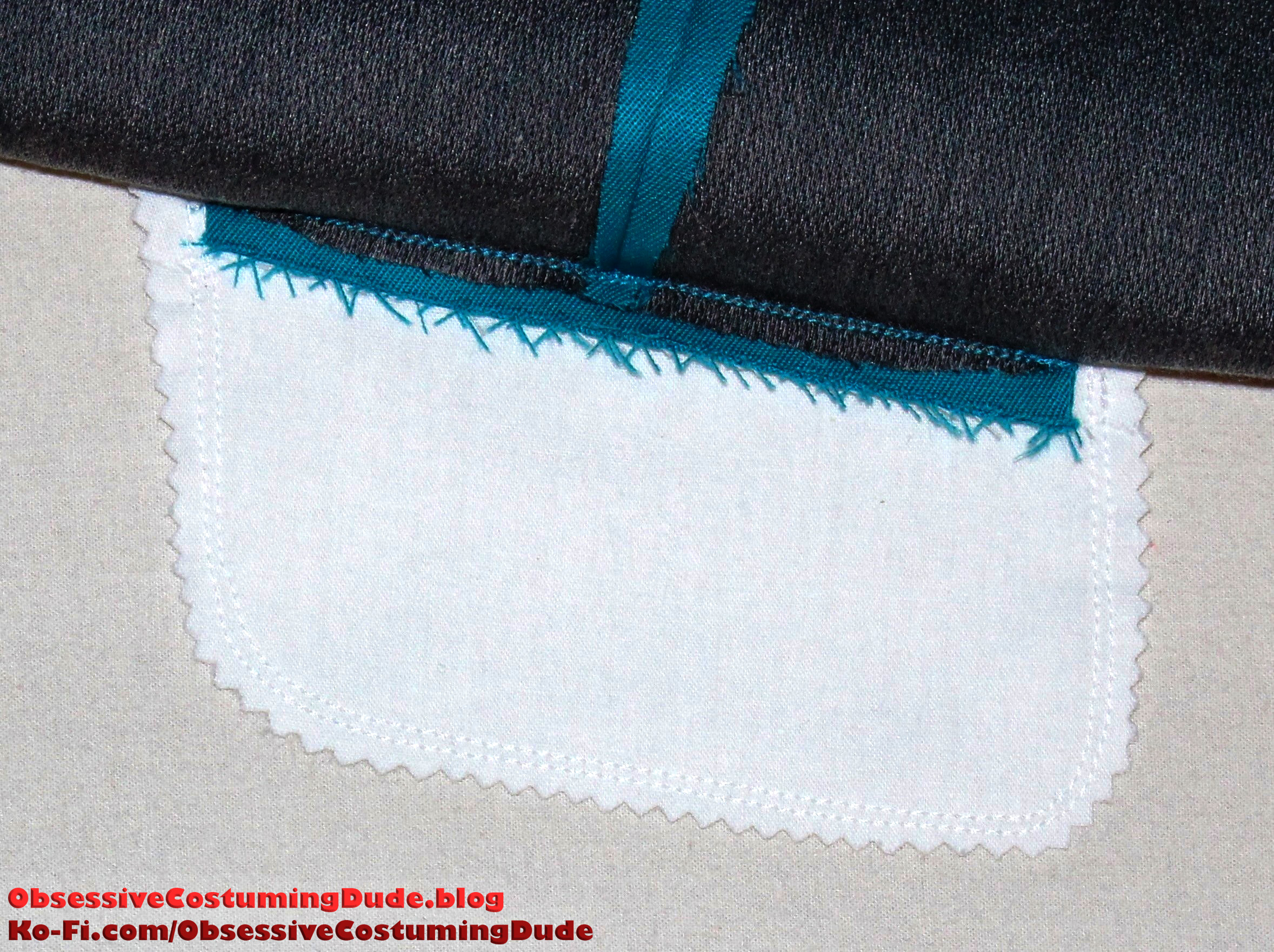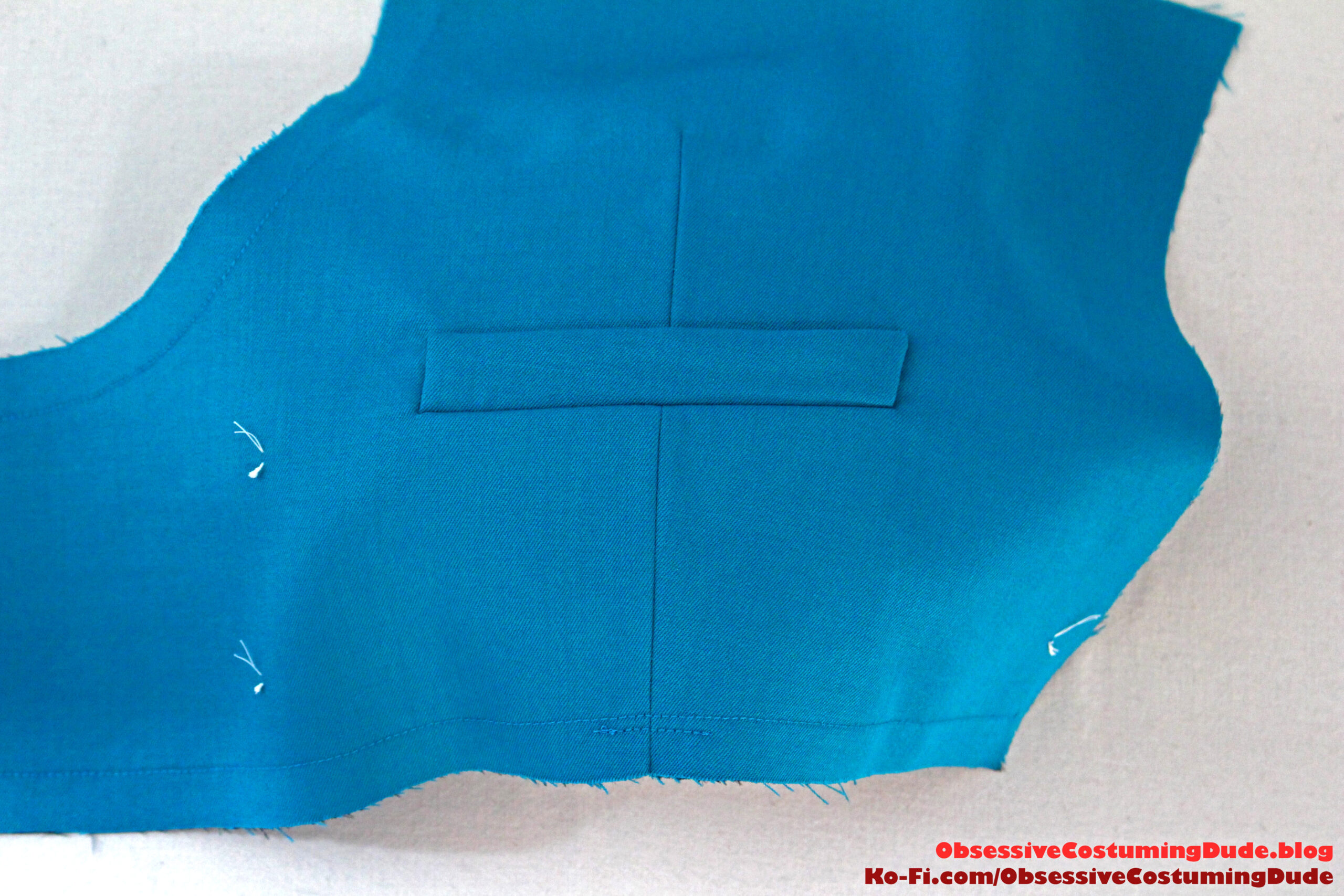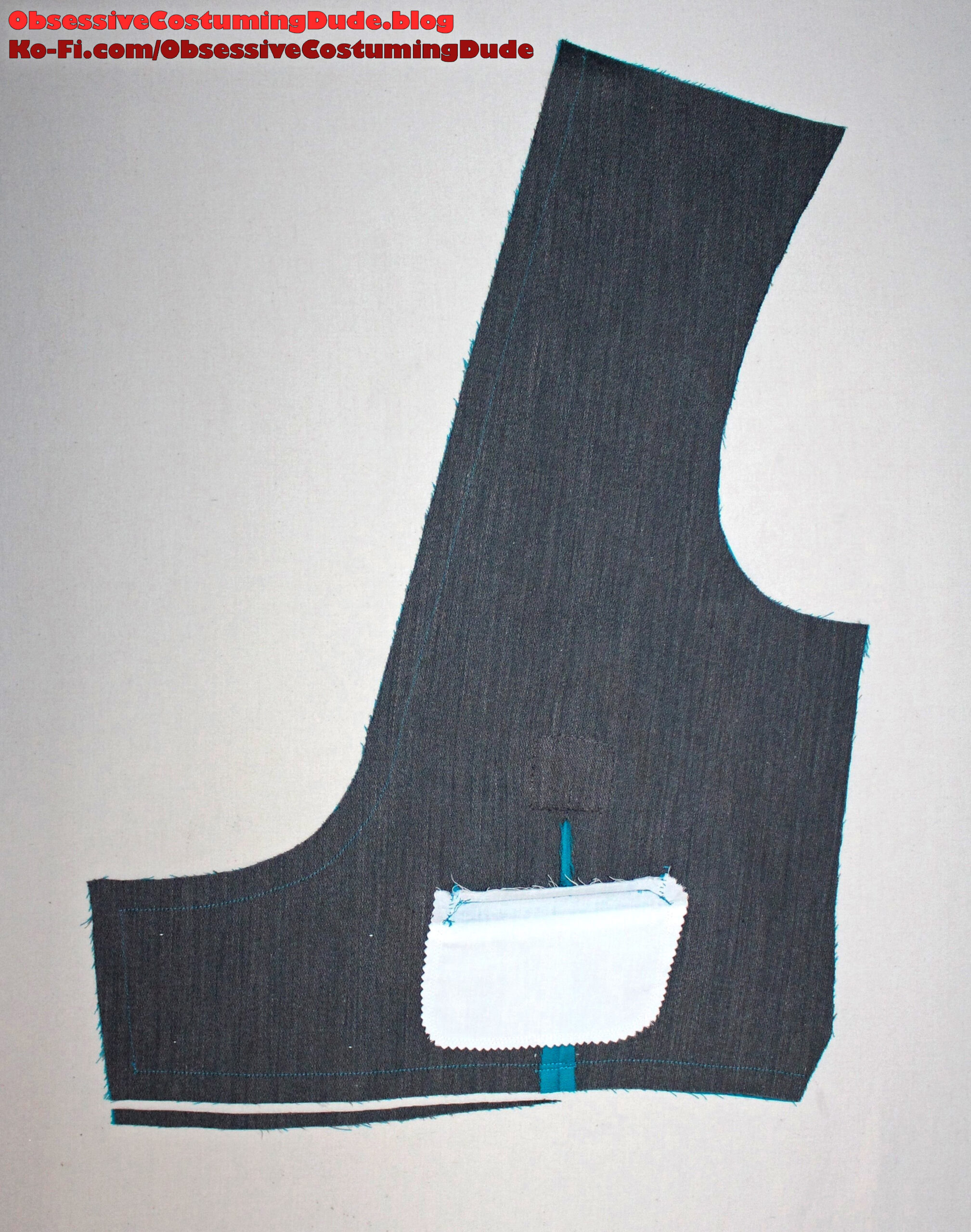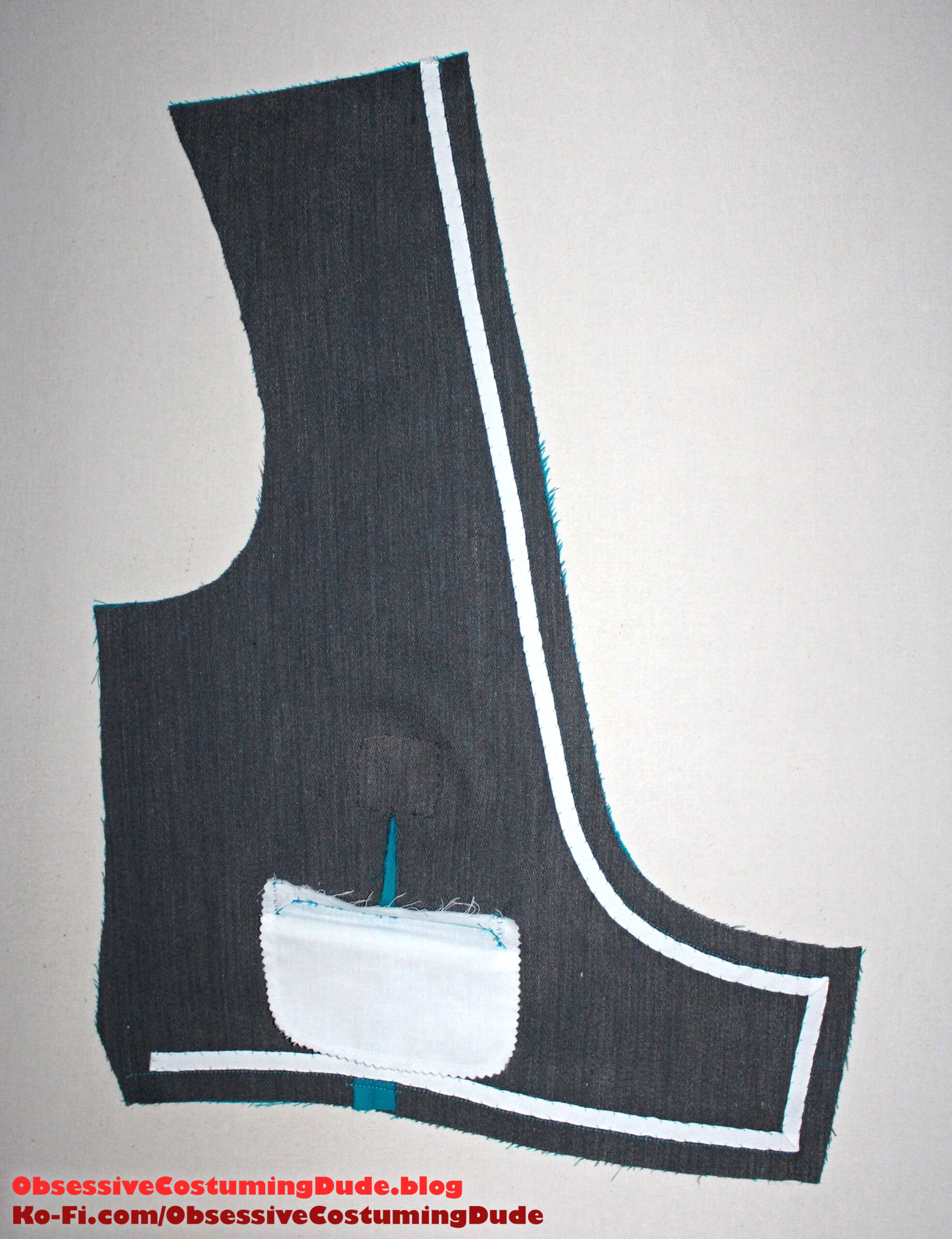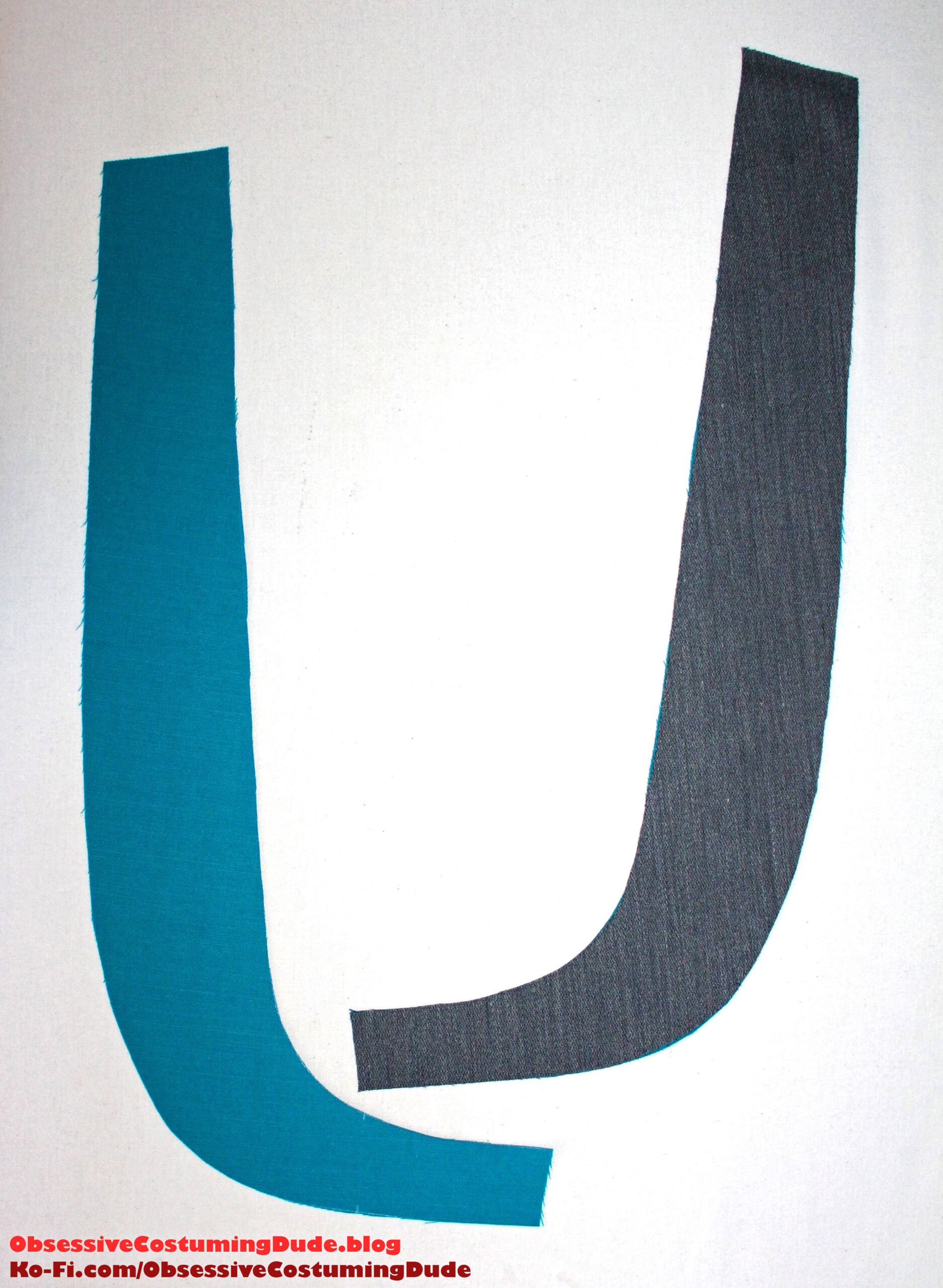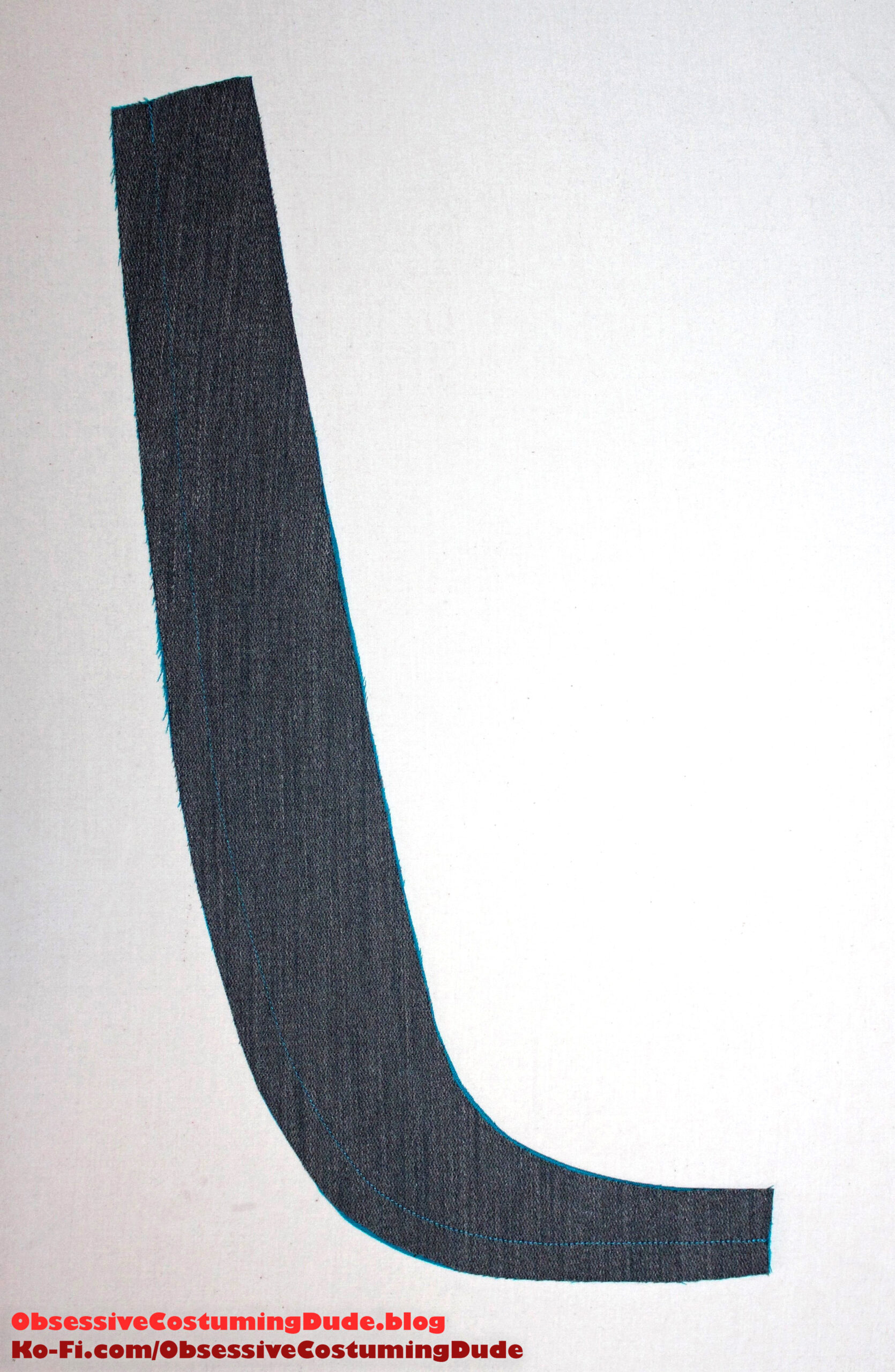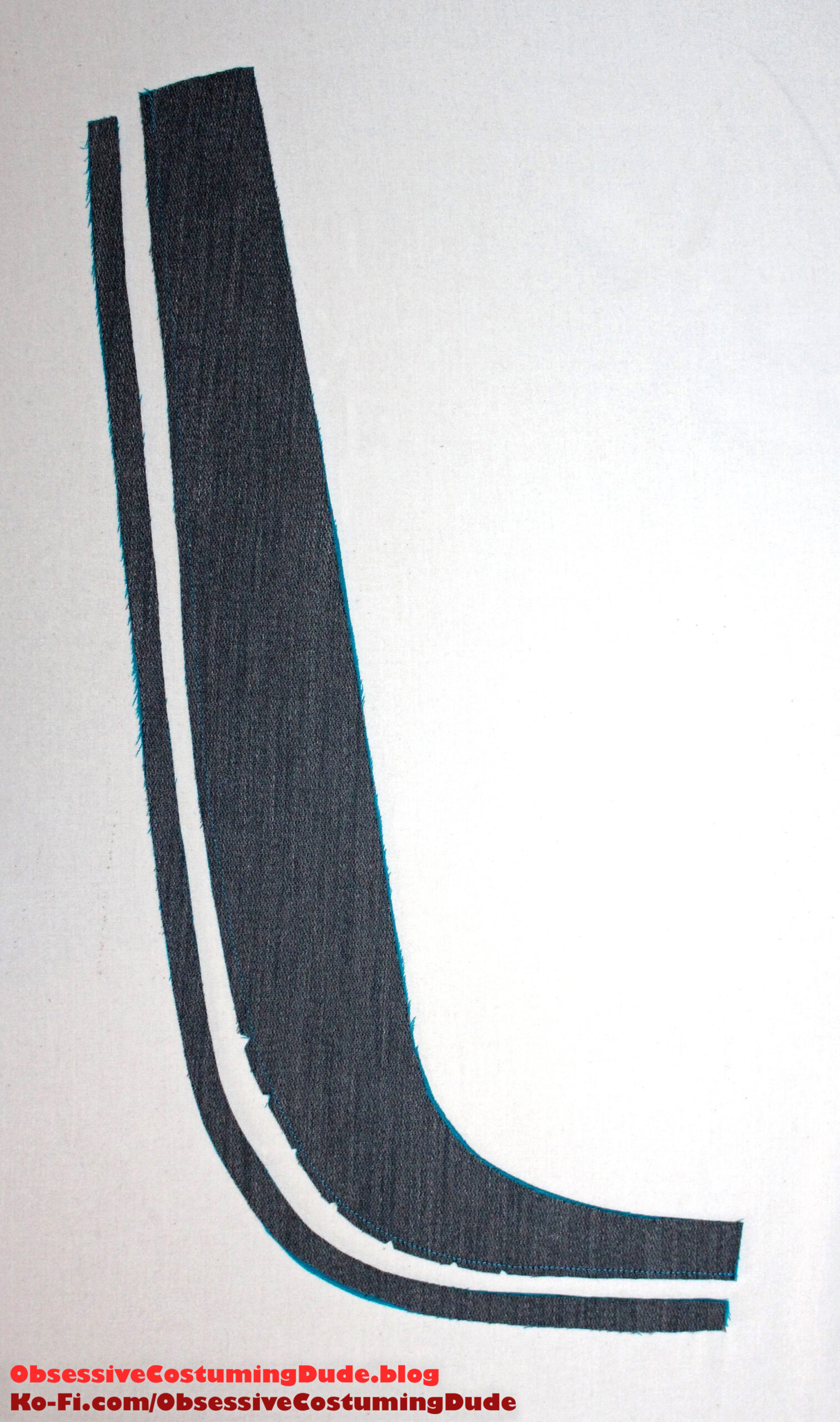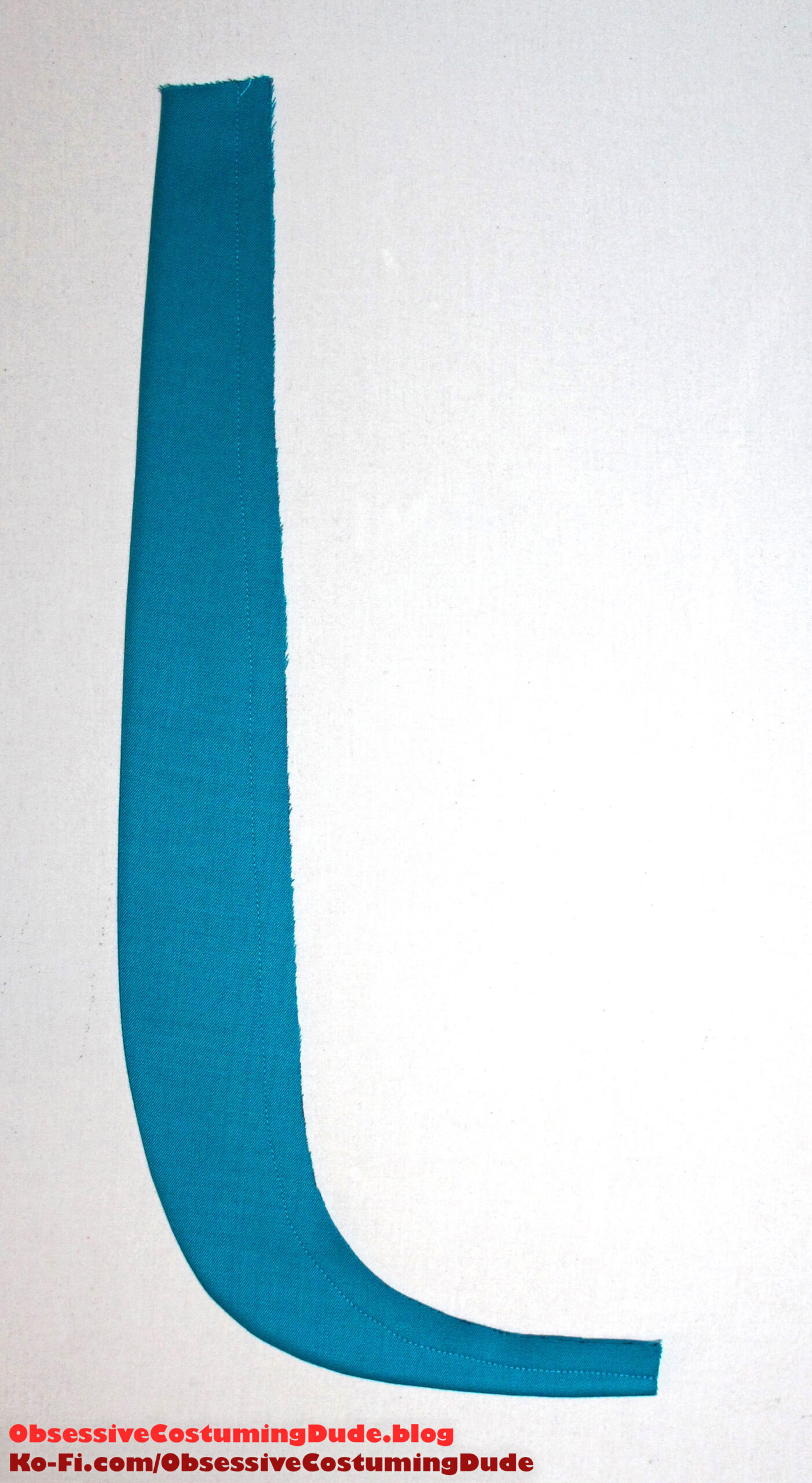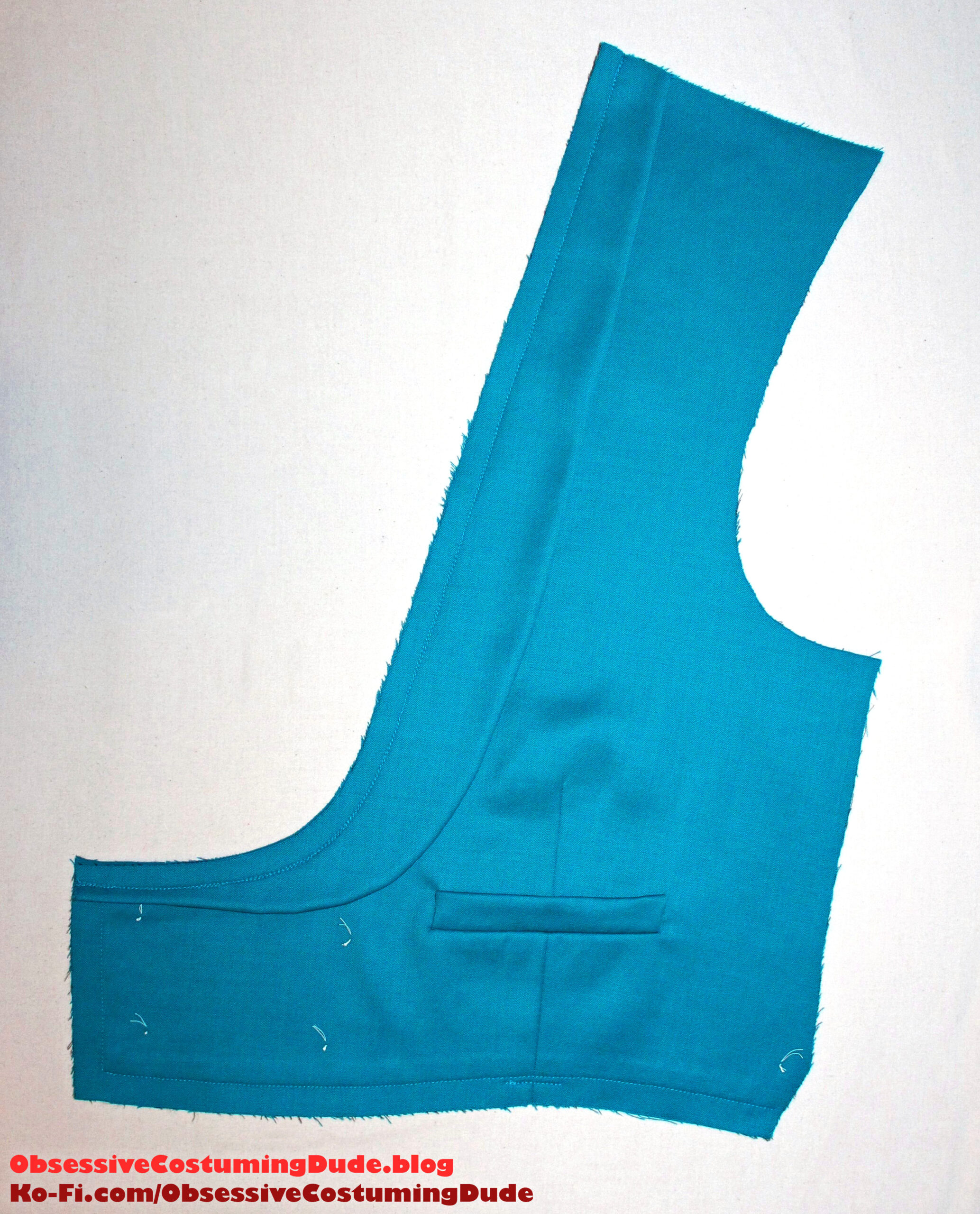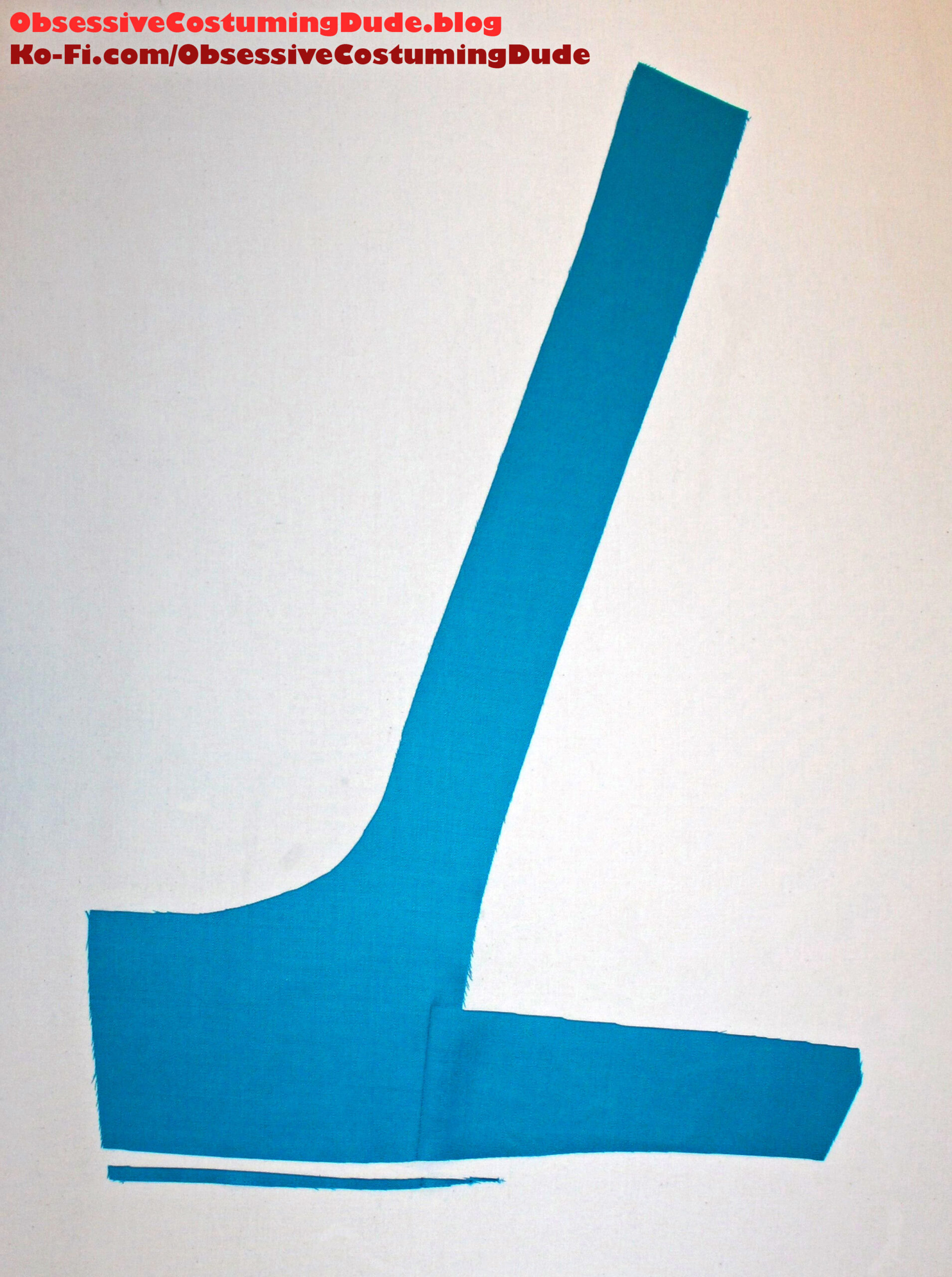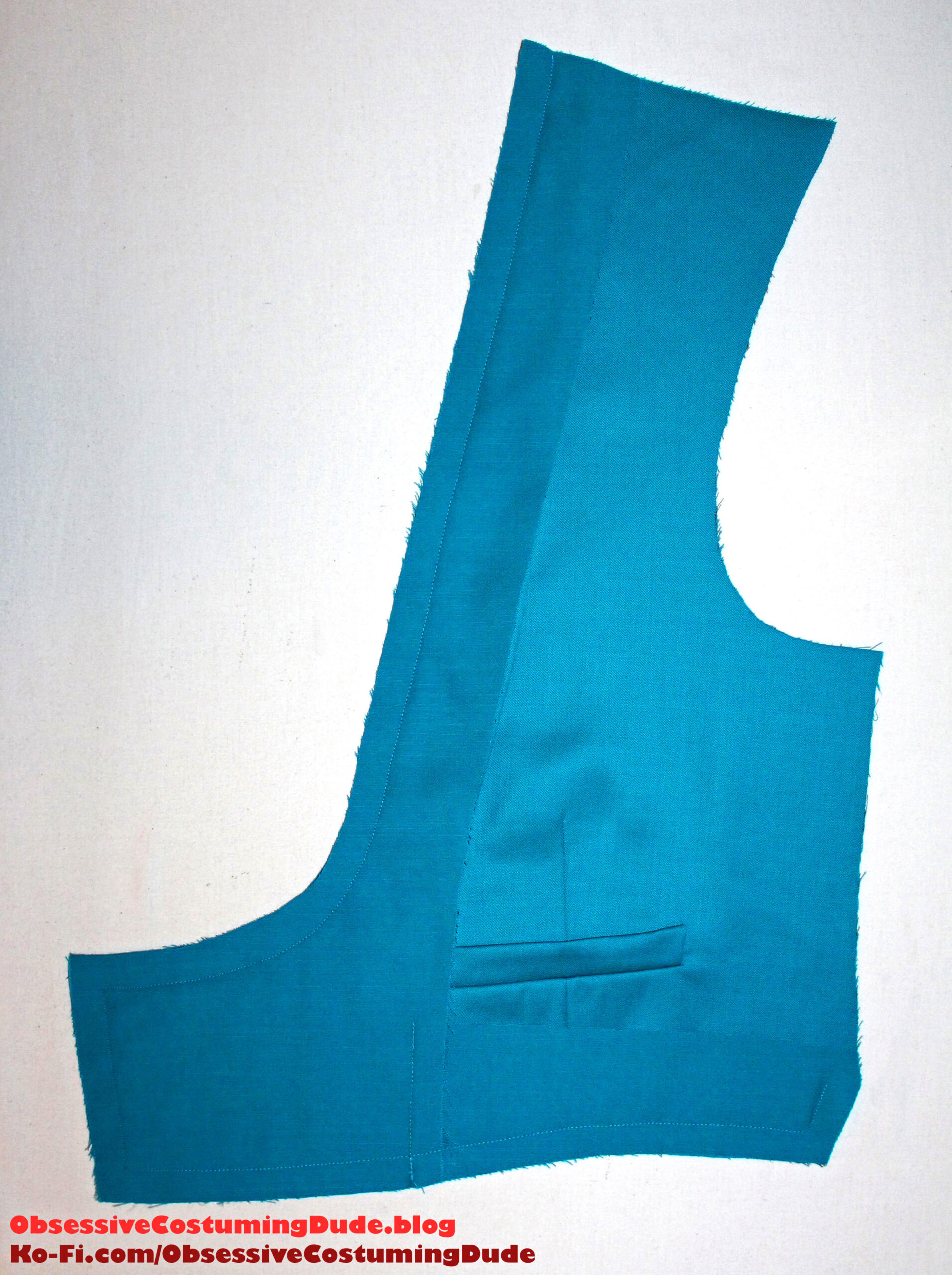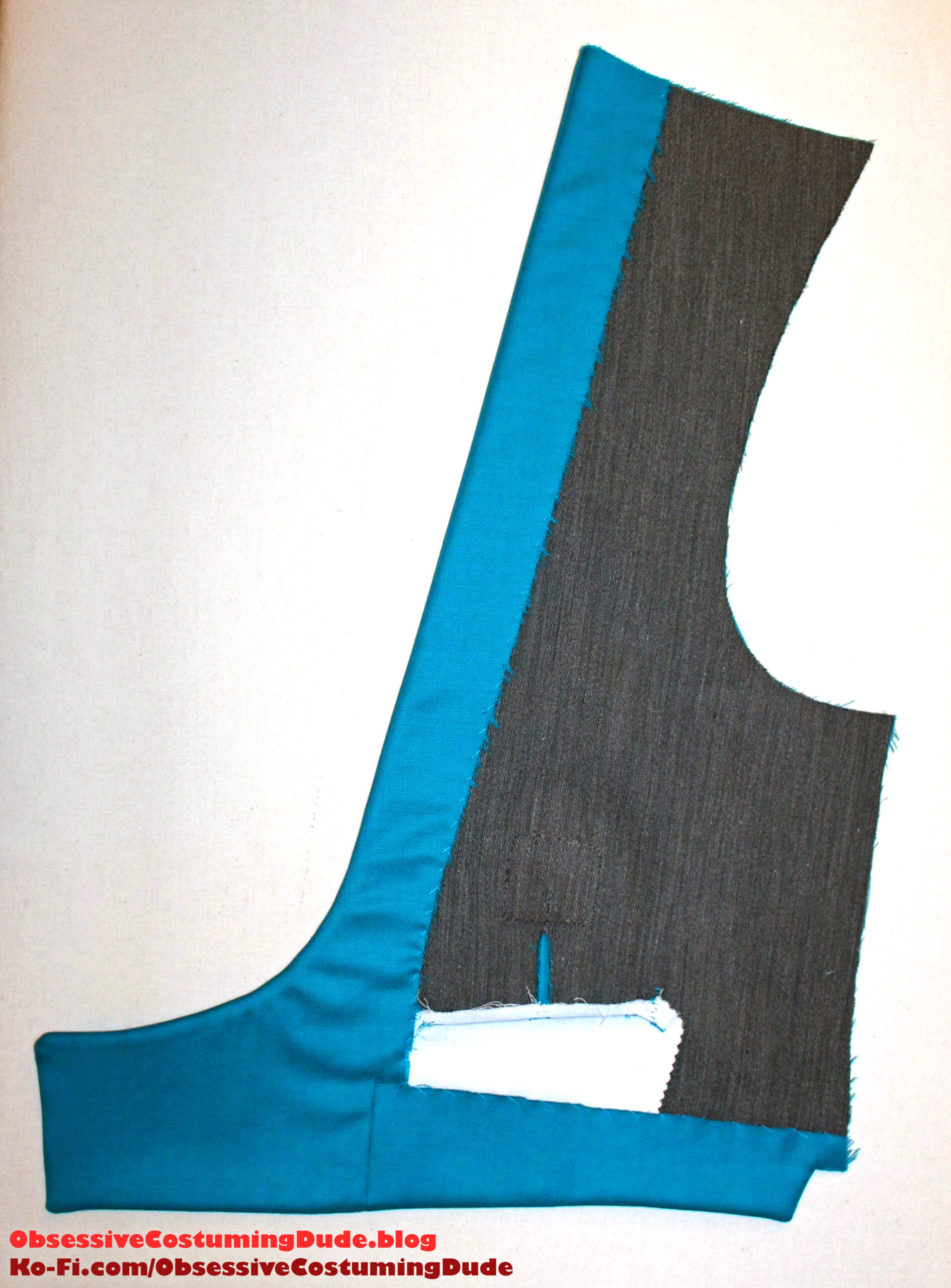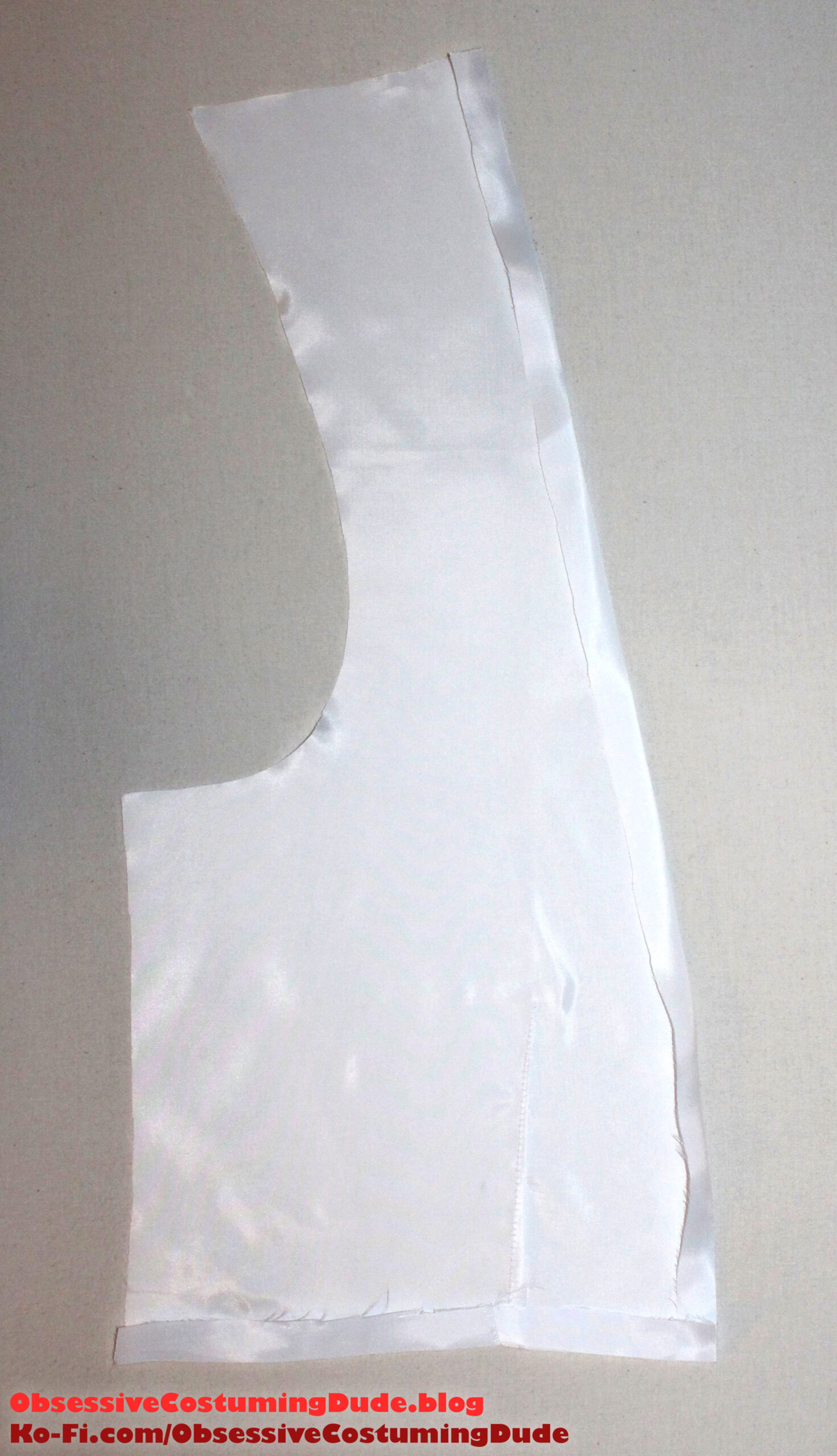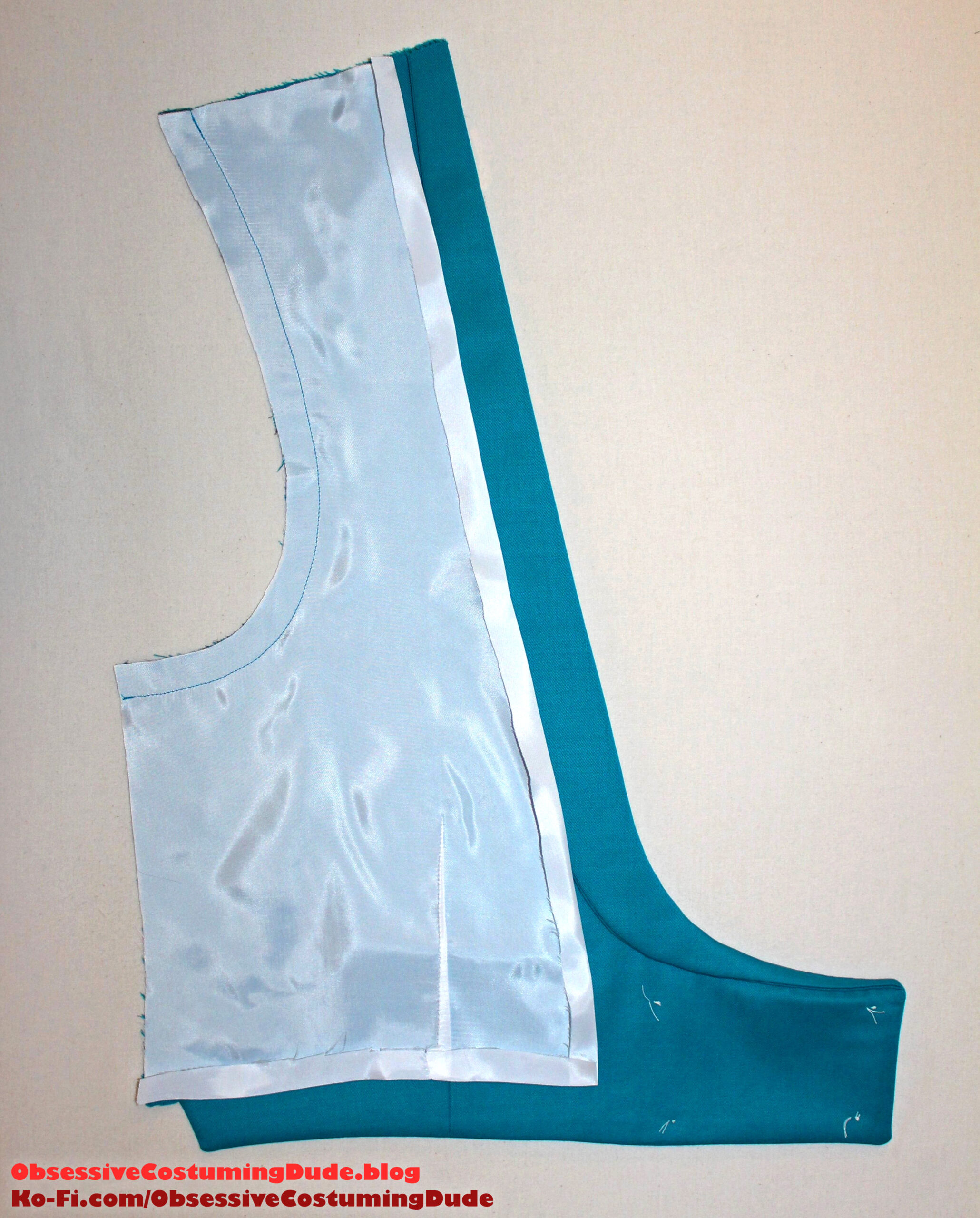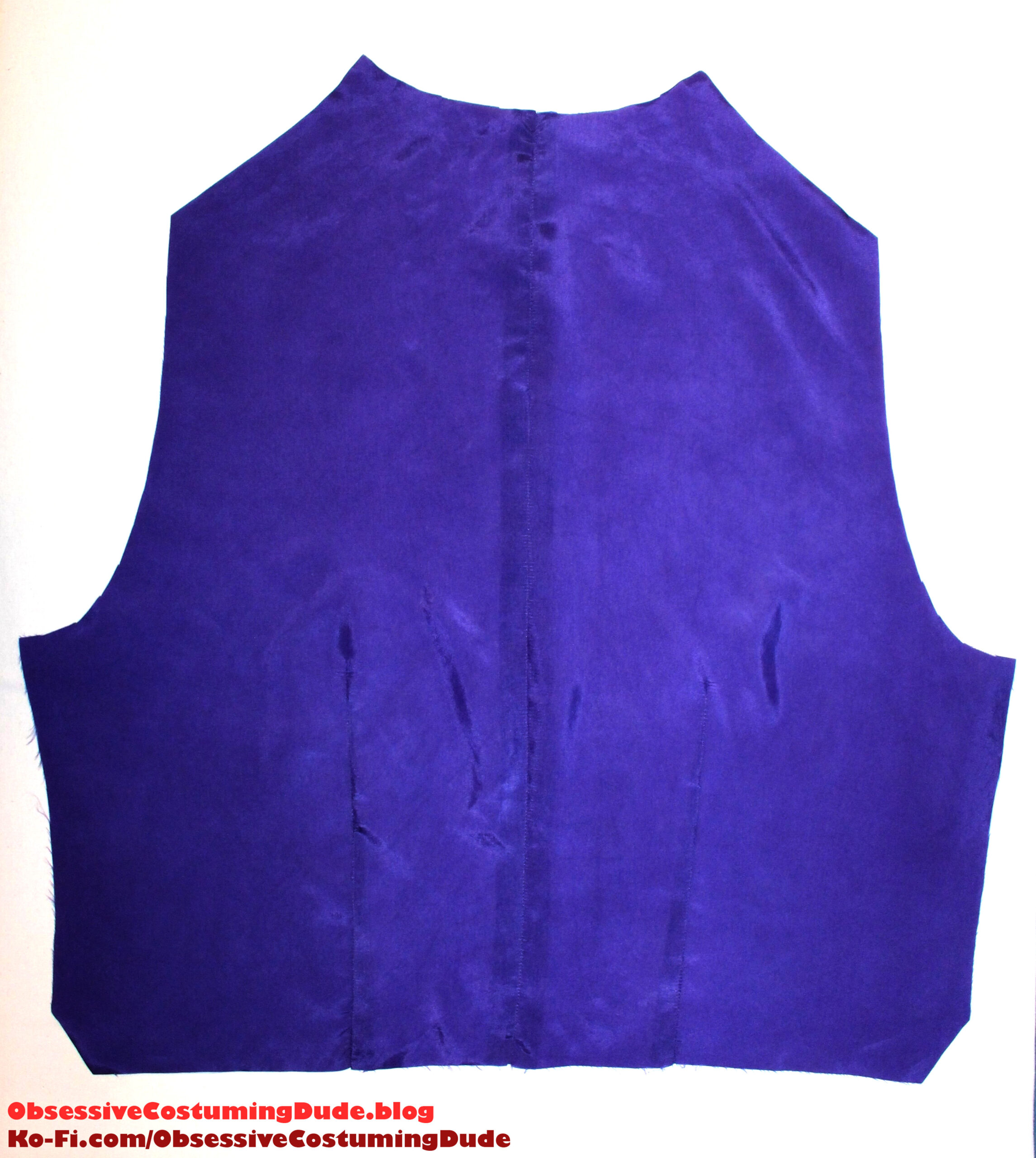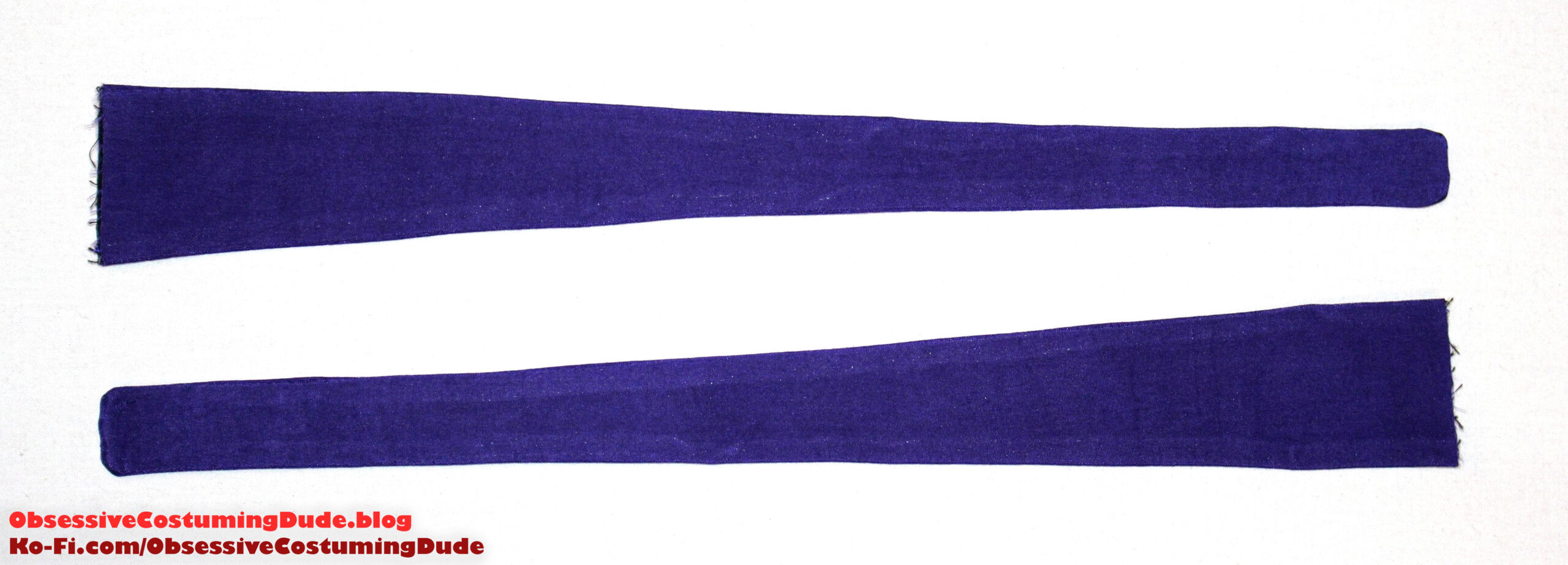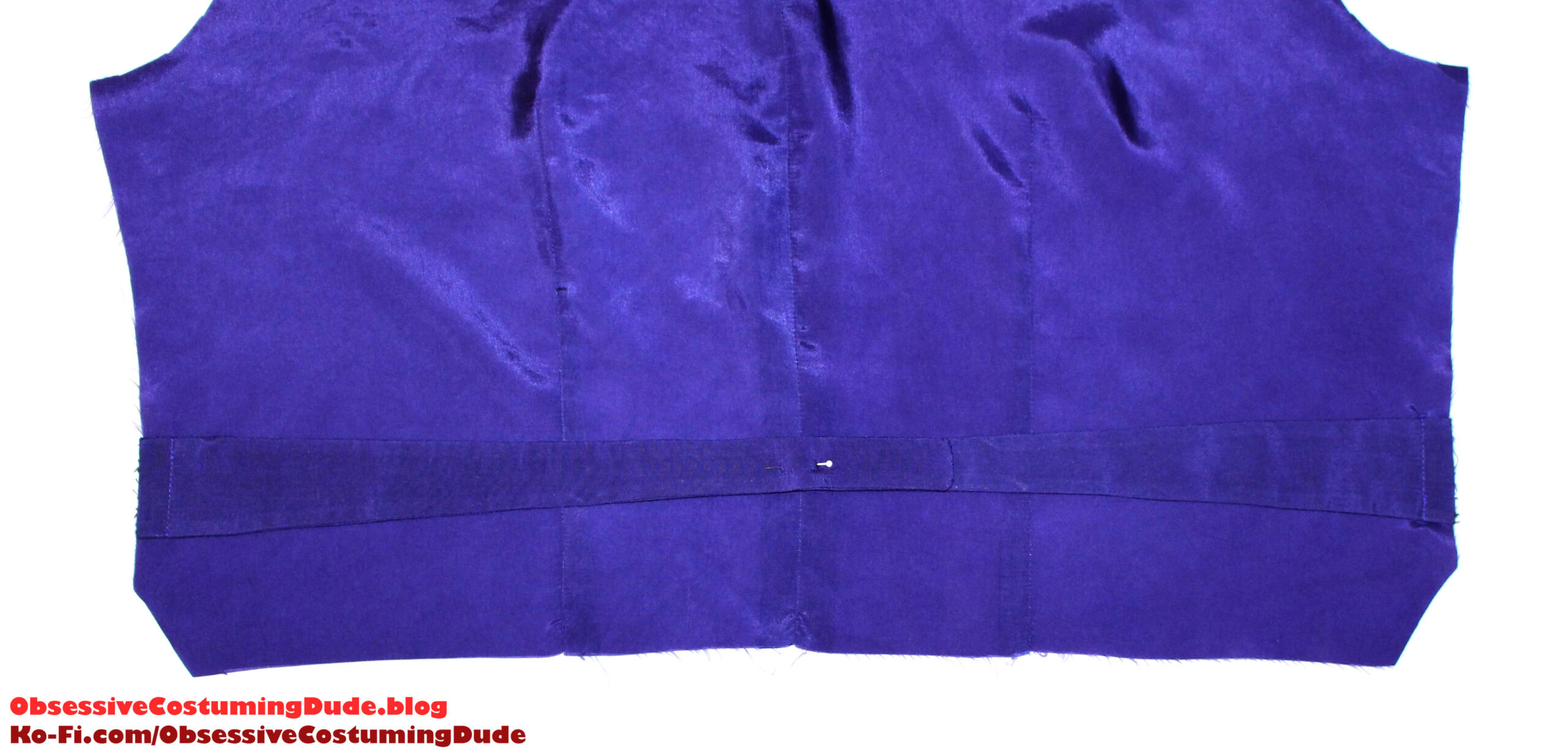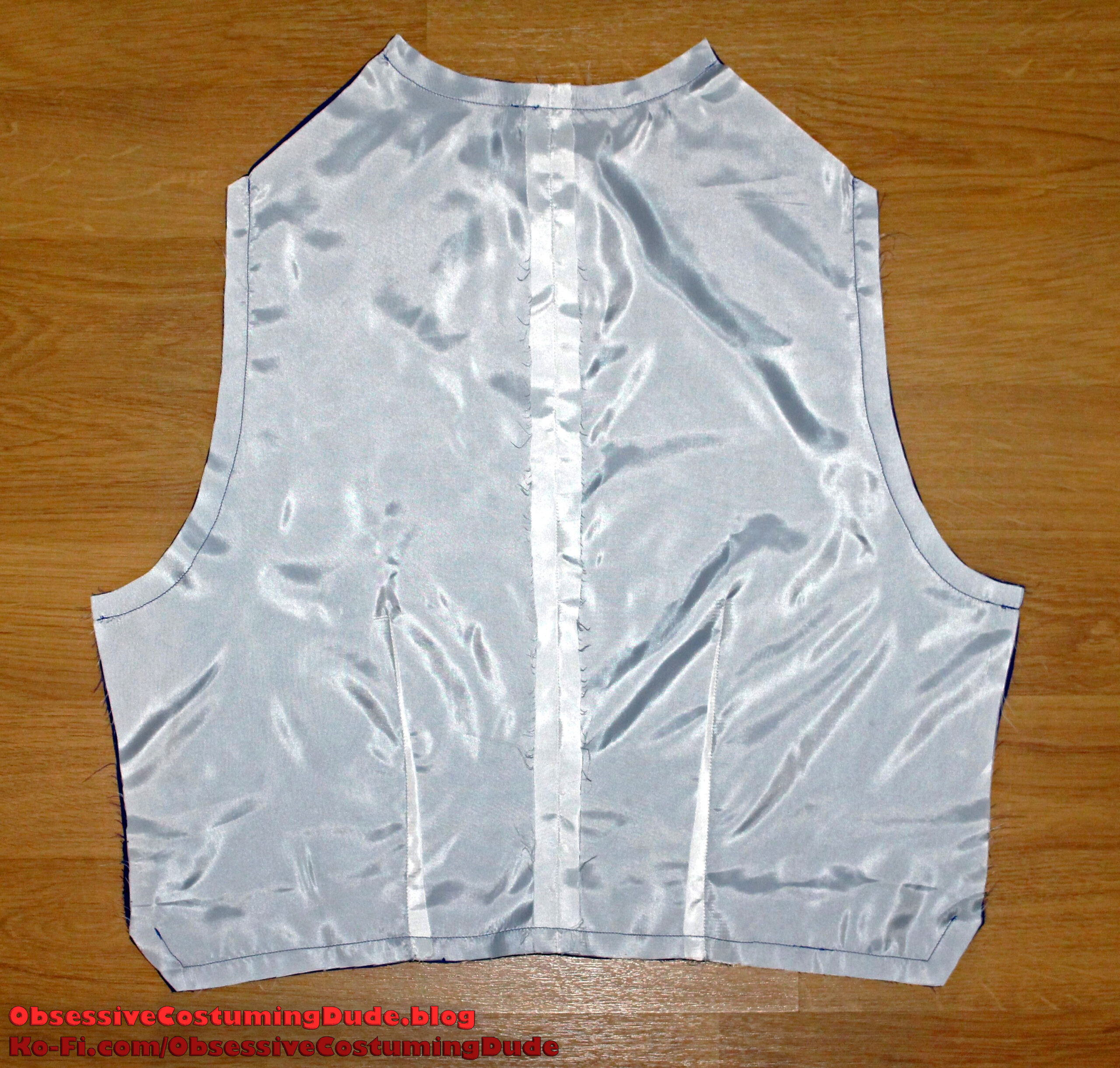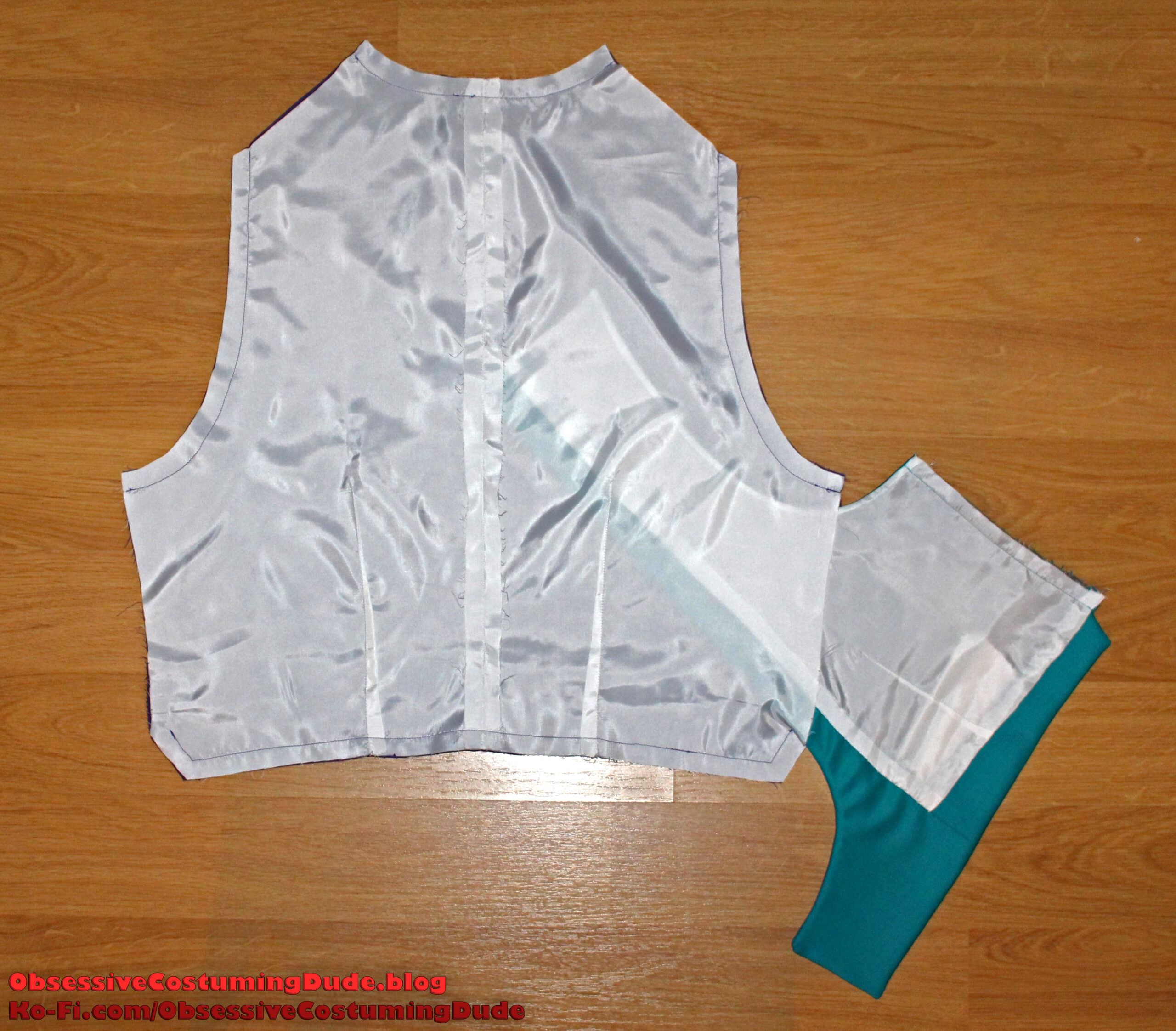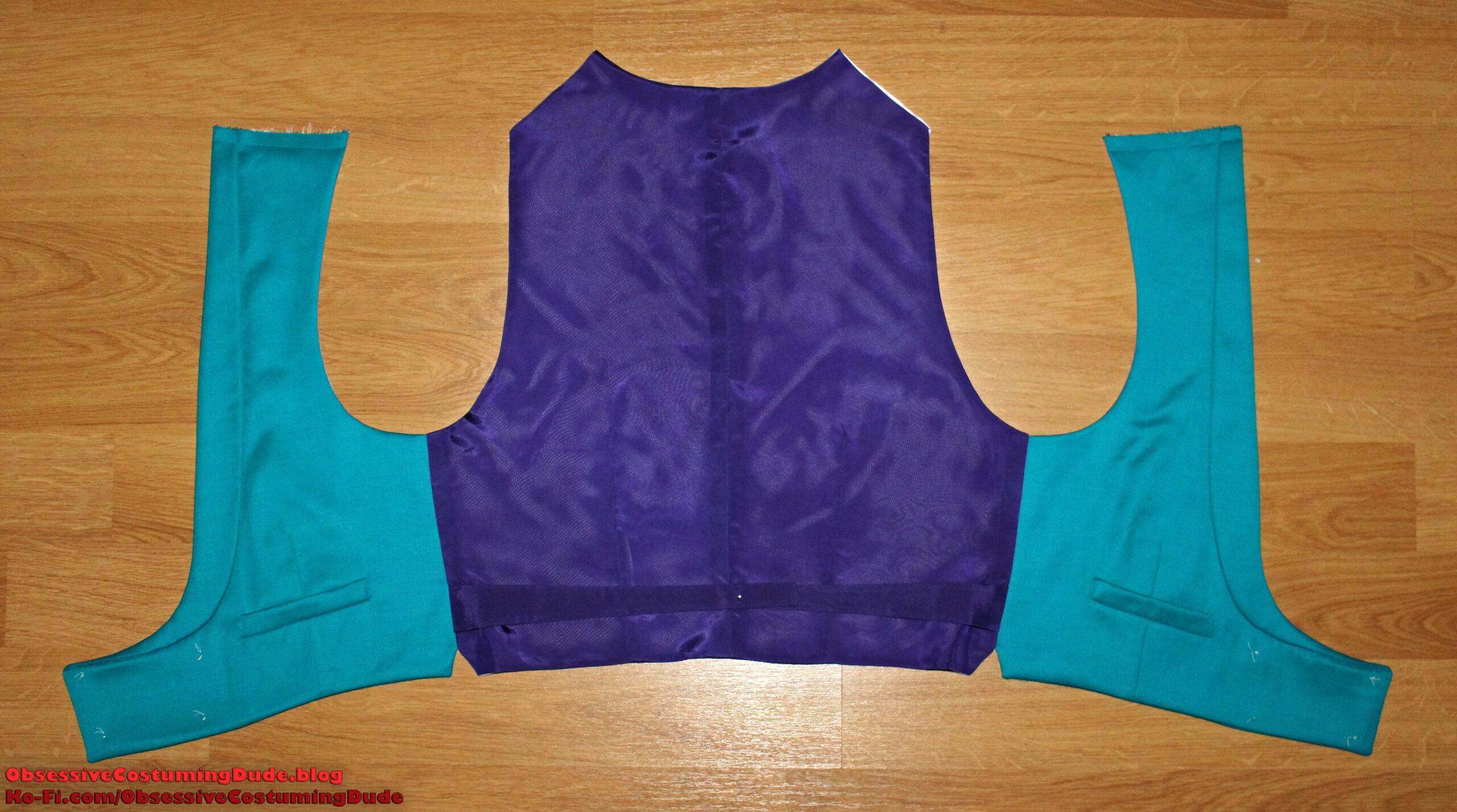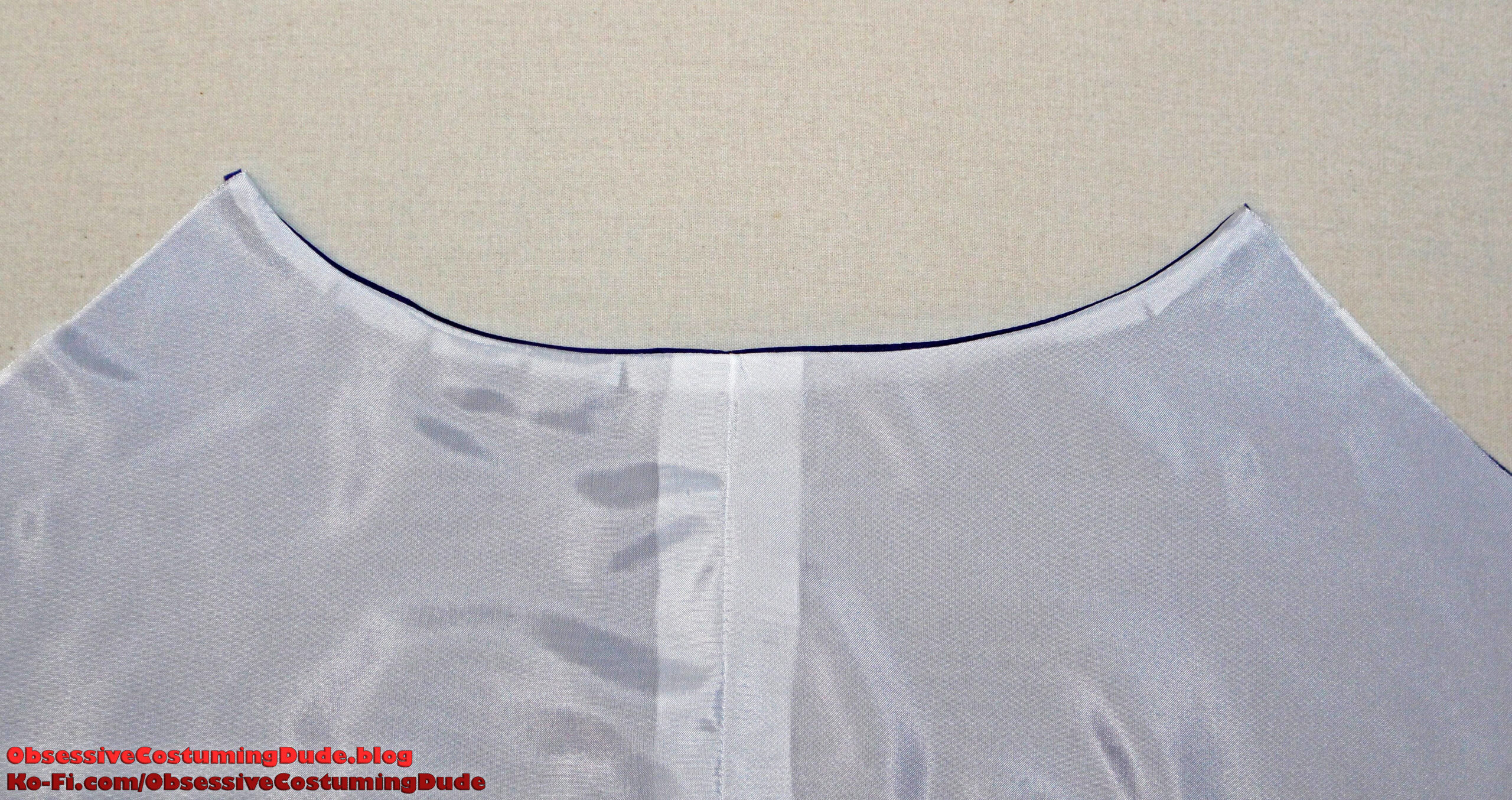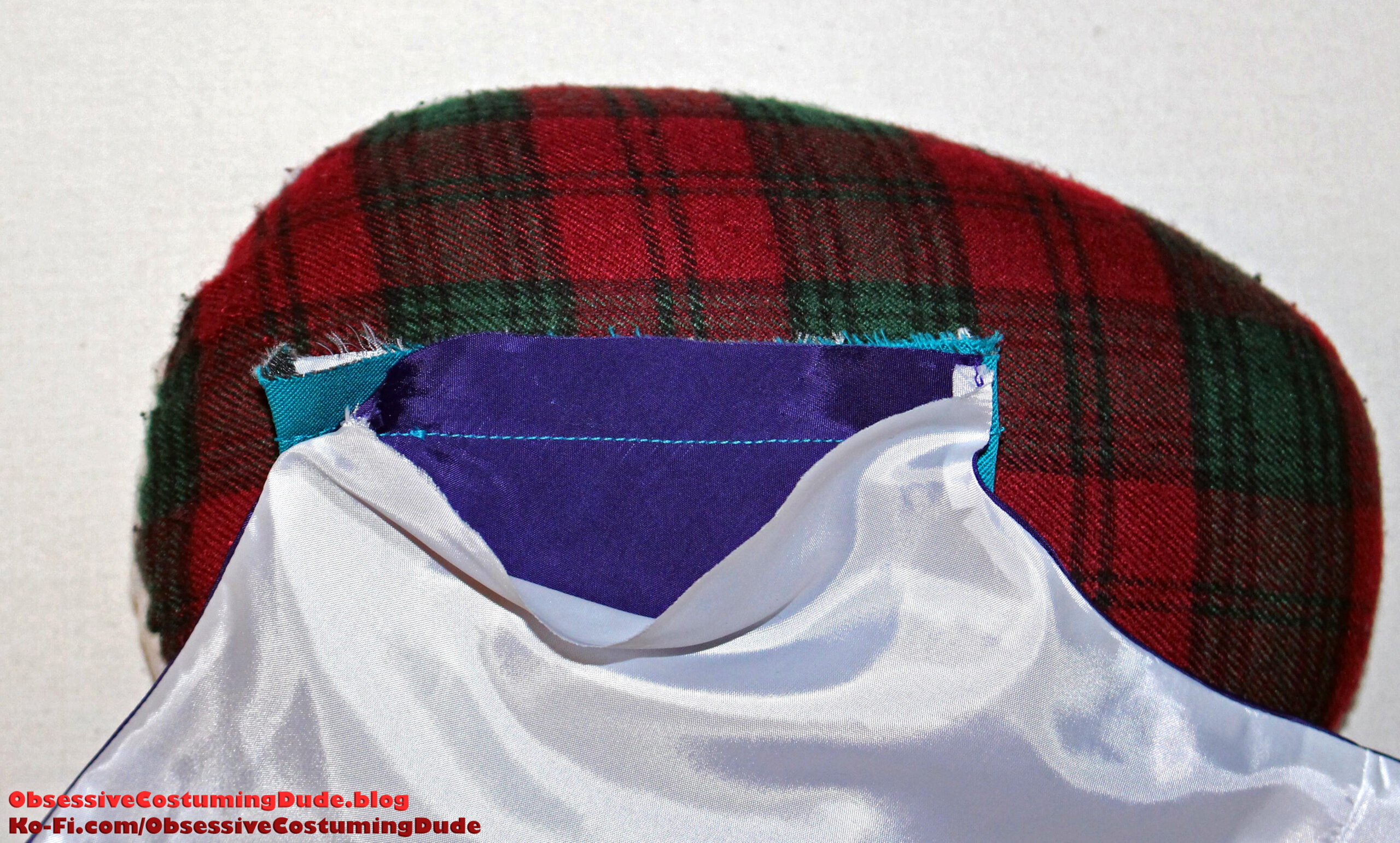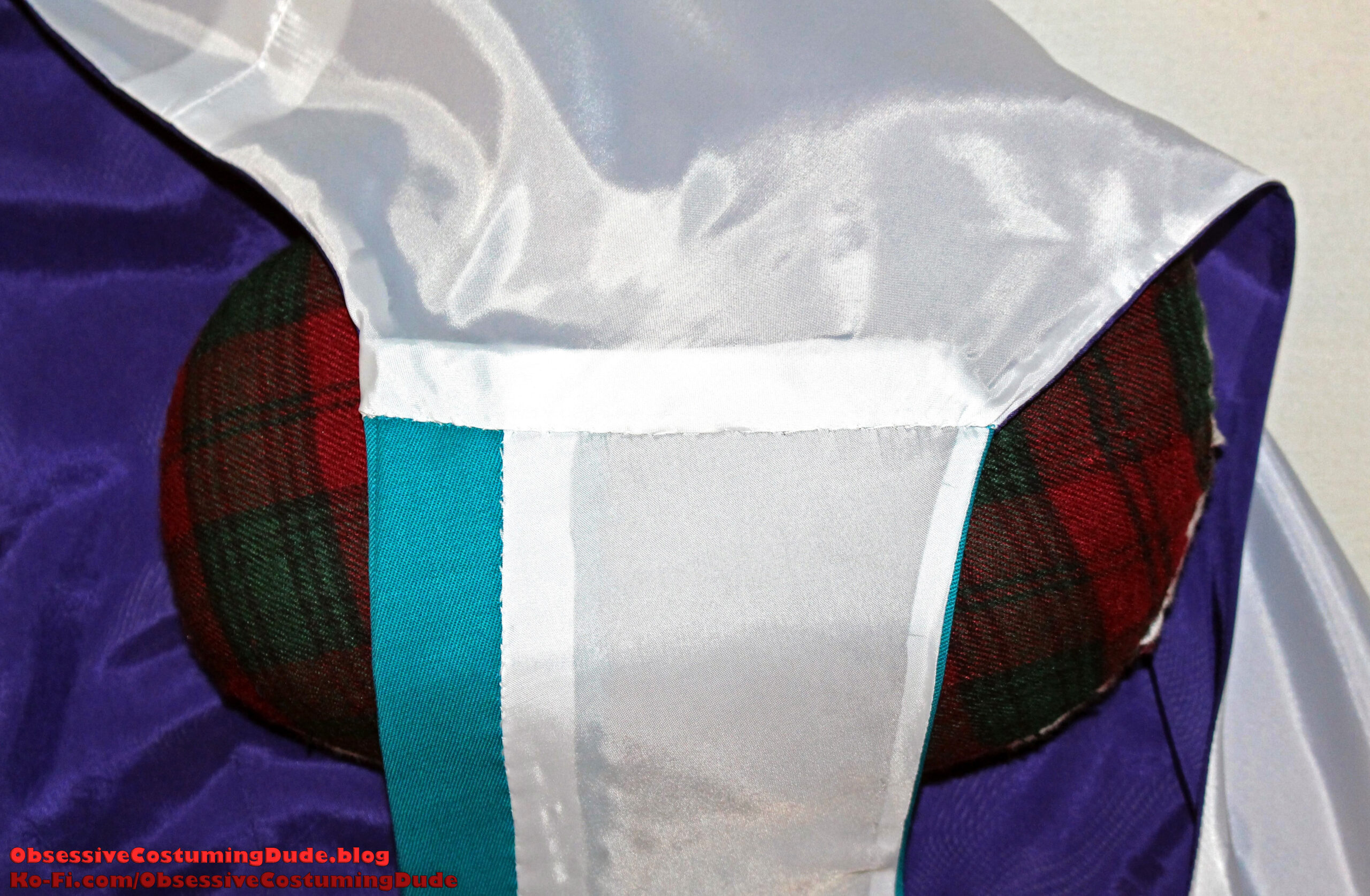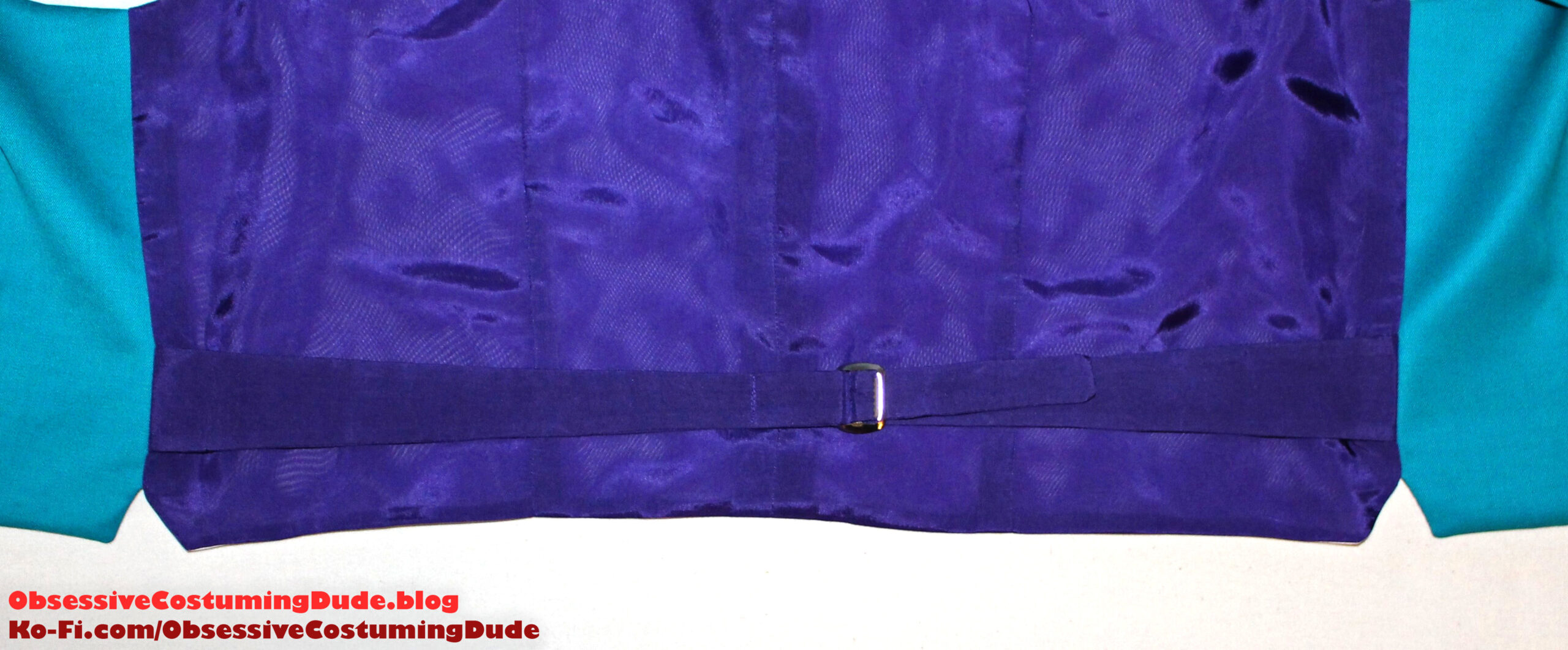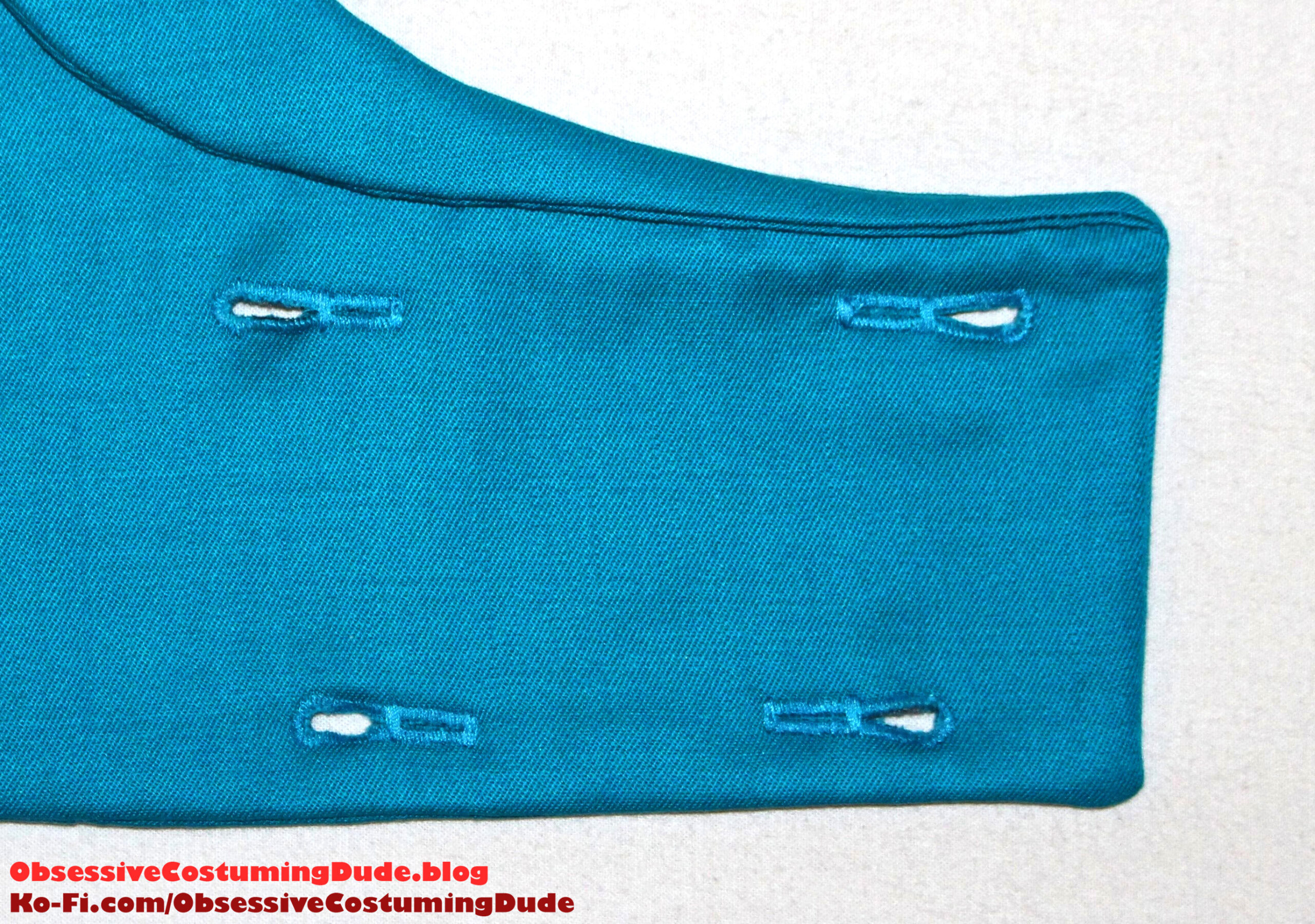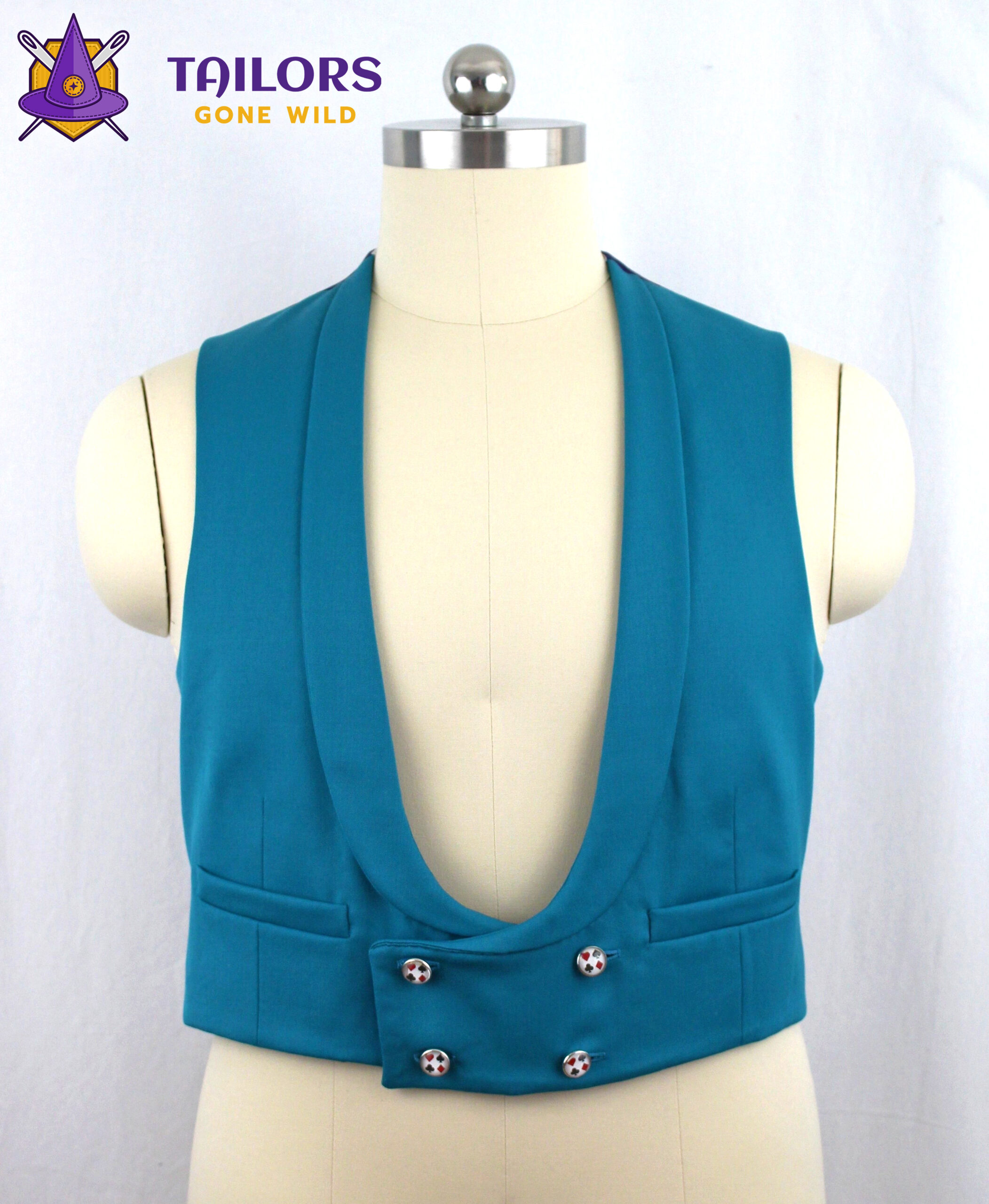ALL SEAM ALLOWANCES ARE ⅝” UNLESS OTHERWISE SPECIFIED!
Cut out your pattern pieces in the manner of your preference.
(I prefer to trace mine onto the fabric with disappearing tailor’s chalk.)
Mark the button and pocket positioning in the manner of your preference; I prefer to use small “tailor’s tacks” using white basting thread.
If you’re using a sew-in hair canvas on the waistcoat front (piece A), also cut a layer for each front panel and shawl collar (piece C), and tailor-baste the layers together.
If you’re using a fusible hair canvas, apply it to the underside of the waistcoat fronts (piece A) and two of the shawl collar layers (piece C).
(I prefer to apply the fusible interfacing to a large area of the fabric before cutting out the waistcoat front, rather than applying it afterward.)
I prefer to sew my darts using Cabrera’s technique from Classic Tailoring Techniques for Menswear.
Sew the lower front dart closed, and slash the dart open up the middle, ending the slit about ½” from the top of the dart. (This distributes the dart evenly and reduces bulk in that area.)
Press this portion of the dart open over a tailor’s ham.
To control the fabric at the tips of the darts, thread a hand-sewing needle and insert the eye end of the threaded needle into the dart tip.
Press the dart tip so the fabric is flat at the center (rather than getting mashed down to one side or the other).
Then pull the needle out by the thread, since the needle itself will be hot, and press the dart tip again.
At this point you could call it a day with the darts and move on, but I suggest going the extra mile and securing each dart tip with a small piece of fusible interfacing. This will help the dart hold its lovely shape at the tips.
A small square is all you need – approximately 1″ x 1″, and ideally cut with pinking shears. The “pinked” edges will help prevent unsightly solid lines along the interfacing edges on the right side of the garment.
I suggest sewing or basting across the bottom of the dart ½” from the lower edge.
Fold the pocket welt in half along the diagonal center, right sides together, matching outer and lower edges.
Sew the outer (short) edges closed.
Trim the outer seam allowances down to ¼”, turn the pocket welt back right-sides-out, and press.
Baste or sew the welt closed ¼” from the lower edge.
Position the welt over the waistcoat front, upside-down, matching pattern dots. The raw edges of the welt should extend ⅜” above the dots.
Hand-baste the pocket welt into place.
Using your quilting/walking foot, stitch the pocket welt to the waistcoat front directly from one dot to the other (⅜” from the raw edges), beginning and ending your stitch exactly at the outer edges of the pocket welt and reinforcing at the ends.
(This stitch line will become the bottom of the pocket opening.)
To ensure proper orientation of the pocket bag (piece H), first place one layer of pocketing over the pocket welt, in the direction the pocket will eventually hang.
Flip the piece of pocketing upward (so it’s upside-down) and slide it underneath the pocket welt seam allowance, as close to the stitch line as you can manage.
Sew the pocketing to the waistcoat along the raw end of the pocket welt, beginning and ending your stitching ⅜” from the ends of the welt. (You may find a zipper/piping foot better suited for this than a walking or all-purpose foot.)
TIP: To help you know exactly where to begin and end your stitching, lightly mark the pocketing with a disappearing ink fabric marker ⅜” from each end of the pocket welt.
Slash the pocket opening halfway between the two stitch lines, taking care to only cut through the waistcoat front and interfacing (not the pocket welt or pocketing).
Approximately ⅜” from the end of the upper, shorter stitch line, pivot and clip diagonally to the last stitch. Repeat for the lower stitch line, then repeat for the other end of the pocket.
(Use sharp scissors for this, and be sure to clip exactly to the last stitch in each corner, but not past them!)
Pull the pocket bag through to the underside, and fold the pocket welt upward along the stitch line.
Press the pocket bag allowance upward, and the pocket welt allowance downward.
Trim away ⅜” from the upper edge of the second piece of pocketing.
With the waistcoat right-side-up, rotate it around 180° so the bottom of the waistcoat is farther away from you, and gently pull the bottom of the waistcoat back toward you until the welt allowance is visible.
Position the second piece of pocketing under the pocket welt so the upper edge of the pocketing is flush with the raw end of the welt.
Pin the second piece of pocketing to the pocket welt’s seam allowance.
Sew the pocketing to the pocket welt as close to the first stitch line as you can manage – across the whole pocket welt this time (don’t leave ⅜” free on each end like you did with the first piece of pocketing).
Press the pocket welt/lower bag allowances downward again.
Pull the little triangular “prongs” on the sides of the pocket opening to the underside (I find tweezers helpful for this) and press.
Pin the pocket bag closed, matching outer and lower edges.
Sew the triangular prongs to the pocket bag, closing the pocket opening.
Using a regular sewing foot, sew the pocket bag closed along the outer and lower edges.
Stitch again ⅛” from the first stitch line (or ½” from the edges) and trim the outer edges of the pocket bag with pinking shears.
Tack the sides of the pocket welt to the waistcoat front from the underside by hand.
On the front of the waistcoat, the finished pocket should look like this:
Repeat for the other pocket.
Because the waistcoat is double-breasted, I suggest trimming away approximately ⅛” to ¼” from the lower center front of the waistcoat right.
I also recommend stay-stitching the waistcoat front and lower edges.
Cut a length of pre-shrunk cotton twill stay tape longer than the waistcoat front and lower edges and pin it into place, so its outer edge is just inside the stay-stitching, following the curves and pivoting at the corners.
Fell-stitch the stay tape to the hair canvas, taking care to only stitch through the interfacing and not the waistcoat fabric itself.
Repeat for the other waistcoat front.
Position the shawl collar onto the corresponding waistcoat front so its upper and centermost edges are flush.
Sew or baste the chawl collar into place on the waistcoat over the previous stitch lines.
Repeat for the other waistcoat front.
Sew the front facing (piece D) to the front hem facing (piece F), right sides together.
Press the hem facing outward, toward the side.
As with the waistcoat right front, I suggest trimming away approximately ⅛” to ¼” from the lower center front edge.
Sew the waistcoat facing assembly to the waistcoat front along the centermost, lower, and lower side edges, right sides together, beginning or ending your stitching at the lower side dot and reinforcing several times.
Trim the seam allowances down to ¼”, and clip them to the stitching along the front and lower curves.
Also clip the seam allowance horizontally to the stitching at the lower side dot.
Turn the facing assembly to the underside and press.
Hand-sew the edges of the facings to the interfacing, taking care to only stitch through the interfacing and not the waistcoat fabric itself.
Over the front pocket bag, be sure to only catch a single layer of pocketing; you don’t want to accidentally sew your pocket closed.
Sew the front lining to the waistcoat front along the armhole, right sides together.
Trim the armhole seam allowances to ¼” and clip them close to the stitching.
Turn the front lining to the underside and press.
Hand-sew the lining to the hem facing about ⅜” to ¼” above the lower, folded edge, forming a small jump pleat for wearing ease.
Slip-stitch the front edge of the lining to the front facing.
Machine-sew or baste the side and shoulder edges of the waistcoat closed.
Sew darts closed on the waistcoat backs (piece B).
Press the darts toward the center back.
Sew the two waistcoat backs together along the center back.
Press the seam allowances open.
Sew two of the back strap pieces (piece F) together along the upper, lower, and centermost (longest and shortest) edges with ¼” seam allowance.
Turn the strap right-sides-out and press.
To help turn the strap right-side-out, I like to use a handy tool called the Dritz Quick Turn (see right).
Repeat for the other strap.
Sew or baste the back straps to the back sides, using the alignment guides on the printed pattern.
Pin the straps down the middle to keep them out of the way until the back assembly is finished.
Sew the two back lining darts closed and press them toward the center back.
Sew the two back lining pieces together along the center back.
Press the seam allowances open.
Position the back and back lining assemblies right sides together and matching edges.
Sew the back lining to the back assembly along the neckline, armholes, bottom, and lower side edges (again beginning/ending your lower stitching at the lower side dots). Leave the shoulders and sides open for now.
Trim the aforementioned seam allowances down to ¼”, and clip them close to the stitching around the neckline and armholes.
Time to “marry” the front and back assemblies!
To do this, first position the back assembly (still inside-out) so the lining is right-side-up, and the front assembly face down.
Open the back side and insert the front assembly top-first into the opening.
The front side edge should just barely fit inside the back side edges, extending from seam line to seam line.
Pin, then sew the front assembly to the back assembly along the side, edges flush and reinforcing your stitching at the lower dots.
Repeat for the other side.
Reach through one of the back’s open shoulders and gently turn the waistcoat right-side-out.
Press the neckline, armhole, side, and lower back.
When pressing the neckline and armhole seams, roll the seam slightly to the underside, to minimize any unwelcome “peek-a-boo” from the lining.
Open the back shoulders and pull the back lining out of the way.
Pin the back shoulder to the front shoulder, matching neckline and armhole seam lines.
Sew the back to the front along the shoulder, again pulling the back lining out of the way.
Press the shoulder seam allowances toward the back.
Press the back lining seam allowance under and slip-stitch the back lining to the front facing/lining assembly.
Attach the back vest buckle.
Make and slash the front buttonholes.
If you’re using proper buttons, I suggest making “keyhole” buttonholes.
If you’re using cufflinks to serve as buttons, you can make a much smaller buttonhole since only the backing rod needs to extend through, not the round link (“button”) itself.
However, if you’d like for slivers of the buttonholes to be visible underneath the cufflinks to make them appear more “real,” I suggest making full-size buttonholes, then closing them about halfway with bar-tacks. (See below.)
And if you’re using cufflinks instead of buttons, you’ll need to make buttonholes on both sides of the waistcoat to accommodate them.

